
- Youth Program
- Wharton Online
- Business Journal Articles
- College, Careers & Job Skills

Green Beans and Other College Essay Tips

Share Article:
Google Classroom:
The Process , a quarterly program that used to air on Sirius XM Channel 111, Business Radio powered by The Wharton School, offered guidance and insight into the college admission process. In this podcast series that began airing in the summer of 2016 and broadcast its fifth segment on July 11, 2017, Eric J. Furda, the dean of admissions at the University of Pennsylvania, invited guests and experts to explore all aspects of the admissions process, from discovery and decision-making to enrollment and transition.
Here in the segment that first aired in October, 2016, Furda speaks with Eileen Cunningham Feikens, director of college counseling at the Dwight-Englewood School, a high school in New Jersey, on a variety of topics, including how to craft the college essay. Feikens and Furda are joined by Elizabeth King, president of Elizabeth King Coaching, which specializes in college-admissions test prep and coaching. Financial aid expert David Charlow joins Furda to talk about college affordability and other issues.
We encourage you to listen to the audio podcast featured below. Meanwhile, just as this year’s college Common Application questions debut this week, here are some expert pointers for high school students who are writing their college essays.
King’s Best Advice : “The essay is the moment where you actually get to introduce yourself. You don’t want to introduce yourself when you were six. You could mention yourself when you were six, but we like to hear about you now. I have an essay that I wrote for myself because I write a lot for fun, and it’s an essay about green beans and visiting my family home a few summers ago and going out back and picking a green bean. That green bean [had] the same feeling and experience as something that happened to me when I was three years old. And I wrote this essay about this interest that I’ve always had in being out back, and the things that I value are continuity, consistency, taking care of things. I would never discourage a student from writing an essay for Penn about a green bean if that’s your vehicle for explaining something really specific and memorable about yourself. Sometimes, the smallest, most tedious things are the places where we actually learn the most about ourselves as people and we can communicate the most about ourselves as people. So, the smaller, the better.”
Feikens’ Best Advice : “Through the supplemental essay prompts of any institution [separate from the Common Application essay questions], the most frequently asked question is, “Why us?” If [you] can successfully weave together things of your experience, things that are important to you, the values that you’re looking for — and really weave together for the Admissions Committee how you expect those to be met or how you hope to take advantage of whatever the institution’s offerings are to create that synergy, that’s going to serve you well. [You don’t want to] just say, “Oh, you’re a really top school and I’m very interested in applying.” Not focusing on the what, but rather on the why and the how. Why are you interested? And how are you going to make use of what that institution has for you?
What I charge my students to do is to think about, ‘What’s the message you’re trying to share?’ Don’t worry about the story; focus on the message. And once you focus on the message and you have that in your head, then look at the prompts and let’s work together to try and find a vehicle that’s going to deliver that message the way you want it to land. So having said that, you want to make sure that it’s a much more reflective essay than narrative. Don’t point the reader outside of yourself. Don’t keep talking about somebody else, like, my great-grandmother and how awesome she was. The student is the main character of his application…he’d be best served if he remembers that.”
Charlow’s Best Advice : “Parents, encourage your students if they’re earlier in the process — eighth, ninth, tenth grade — to please, please, please take your writing assignments and your English classes and your History classes seriously. The quality of the writing, from a grammatical standpoint, is really not very high. I think that a lot of writing assignments are graded based upon the critical thinking and the ideas, and not so much time is being spent teaching students how to write. Students who wait — as teenagers do — to the last minute for their writing assignments, you never learn how to write well. It’s a problem that I have observed in reading lots of essays these last few years.”
Furda’s Best Advice : “The Common Application general essay prompts – there are a half-dozen – can give you an idea of how you can navigate your essay, whether you’re talking about your context or background or important experiences that you’ve learned from. It’s a guiding prompt. It’s an opportunity to think about yourself and how you can tell your story. You want to make sure you are using your own voice. Don’t try to use the thesaurus to sound a certain way. Authenticity and genuineness are important here. Use your tone and use your words. Let your voice come across in the common application general prompt essay. This is telling your story in a general context to help any admission office, college or university understand you better.”
Related Links
- Quizlet: College Admission Vocabulary
- Unigo: How Should the College Essay Tie Into the Rest of the Application?
- College Scorecard
- Elizabeth King Coaching
- P.217: Dean Eric Furda’s Blog
- AccessApplied.com
- All 5 Parts of The Process Podcast
Conversation Starters
Eileen Cunningham Feikens says, “You want to make sure that it’s a much more reflective essay than narrative.” What does she mean by this?
What is Elizabeth King getting at with her green bean example? What does she mean by, “the smaller, the better?”
4 comments on “ Green Beans and Other College Essay Tips ”
As a [somewhat] nervous rising senior applying to college, this article opened a whole new avenue to how prestigious schools (like Penn) view their 40,000+ applicants.
I love the way King presented her inspiring thoughts and ideas – there’s so much value in making yourself memorable. I can wholeheartedly relate to what she’s saying about something even as simple as green beans.
This article definitely got me thinking – If I want to get into a school like Penn, I’ve got to stand out. I can’t just be student number 40,001 who gets good grades and test scores. It really got my creative juices flowing also! Honestly, don’t be surprised if I write my essay about Angry Birds, Minions, Monday mornings, my swing set, or even a fruitful cake. To tell a story and deliver your message, you’ve got to write about something that sparks the fire and adrenaline inside – that’s how your story, and more importantly your message, (as Feikens mentions) comes to life.
This article’s officially inspired me to set one goal for myself, and that goal starts today: Make sure your essay makes an admissions officer cry or laugh uncontrollably (or both!). Make sure you take a risk and sacrifice the “fluff” and get straight to the true you. Sarcasm, humor, and everything in the middle, make the essay your own work of art. If the college doesn’t like it, that’s their problem!
The art of writing analytical essays is slowly becoming extinct, as verified by the innate panic seniors face in writing their personal statements. Although often viewed as mundane and tortuous assignments, the value of learning how to write research papers throughout middle and high school is essential to a student’s growth as a writer.
Reflection requires self criticism and introspection which can certainly be overwhelming to a teenager, yet so important to conveying a message. I admire King’s advice to utilize small anecdotes to paint a broad picture of yourself. I agree that often it’s the small moments in our life that define our essence even more than our accolades. As a rising senior, this article is invaluable to my goal of successfully completing my college application essays to truly depict my values, strengths and aspirations.
I am only in ninth grade but I am already thinking about what school I want to go to, what profession I would like to pursue, and how I am going to achieve these. This article really got me thinking at how not a lot of people actually know how to properly write and it is very astounding when I go to peer review my classmates essay. I would like to thank the people that wrote this article because it will come in use over the years as I progress my way through my high school life and especially when I go to write my college essay.
What Feikens is trying to say is that you should try to tell the reader what you can do and make sure the essay is well rounded. If I was a person reading an admission essay, I would want to try to get an essence of the entire person, and not just one part of them from a story. King is trying to say that people should keep it simple and try to focus their essay at what they are good at. Sometimes, the smallest things set you apart from others. Everyone has good grades, everyone is in 4-5 clubs, but the tiny details are the ones that have a big impact. Try to accomplish things that are original and unique throughout high school.
Leave a Reply Cancel reply
Your email address will not be published. Required fields are marked *
Save my name, email, and website in this browser for the next time I comment.
Related Articles
The conversation: navigating the nuances of emotional intelligence, young entrepreneurs prepare to fuel detroit’s comeback.
- Search Please fill out this field.
- Newsletters
- Sweepstakes
- Healthy Eating
- Best Healthy Foods
What Happens to Your Body When You Eat Green Beans Regularly
Boost your health in a snap with these delicious green legumes.
Devineé Lingo is a registered dietitian nutritionist who is on a mission to cultivate health and wholeness in people seeking restoration and renewal. Her nutrition philosophy is to dig deeper and identify the root causes of people's health concerns using a holistic, integrative and functional approach.
:max_bytes(150000):strip_icc():format(webp)/devinee-lingo-59ed62f55dd5428b8f6cf8aeb5d8a3ad.jpg)
- Health Benefits
Nutrition Facts
- Potential Side Effects
- How to Choose and Store Them
- Best Recipes to Try
PHOTOGRAPHER: MORGAN HUNT GLAZE, FOOD STYLIST: MARGARET MONROE DICKEY, PROP STYLIST: SHELL ROYSTER
Green beans are much more than a simple side dish. Characterized by their elongated appearance and crisp texture, green beans are among the oldest cultivated crops in the world. These versatile edible-podded legumes have become a staple food in many cultural cuisines. Whether you enjoy them stewed, stir-fried, roasted or baked into a holiday casserole, they make the perfect addition to any meal.
Beyond their culinary versatility, green beans are packed with nutrients that offer many health benefits. They are filled with fiber, vitamins, minerals and plant compounds that make them ideal for regular consumption. Keep reading to learn more about how regularly consuming green beans can affect your overall health and well-being.
Health Benefits of Green Beans
May promote strong bones.
Green beans deliver an impressive amount of bone-strengthening vitamin K, making them a delicious way to support your skeletal health. More specifically, vitamin K aids in activating osteocalcin, a protein that plays a role in bone mineralization. As such, vitamin K has been found to reduce bone fractures significantly. Therefore, consuming green beans can help keep your bones strong and resilient.
May Enhance Your Immune Function
When it comes to supporting your immune system, one of the first nutrients that typically comes to mind is vitamin C . Whether you’re dealing with a runny nose, congestion, cough or sore throat, research has revealed that vitamin C can help dial down the intensity and shorten the duration of common cold symptoms.
While citrus fruits are renowned for their vitamin C content, it may come as a surprise that green beans are also a source of this immune-enhancing nutrient . A 1-cup serving of green beans provides 16% to 18% of of vitamin C's recommended dietary allowances. So, the next time you’re feeling under the weather, consider boosting your intake of this essential nutrient with a serving of green beans.
May Support Your Gut Health
If improving or maintaining your gut health is one of your top priorities, green beans are a gut-friendly legume to keep stocked in your fridge. These long legumes are rich in dietary fiber , a nutrient that promotes bowel regularity and feeds the beneficial bacteria in your gut.
Green beans are also considered low in FODMAPs (fermentable oligo-, di- and monosaccharides and polyols), which are carbohydrates that can lead to abdominal discomfort, gas and bloating in those with irritable bowel syndrome . Therefore, green beans are a great option for those following a low-FODMAP diet.
May Improve Your Heart Health
The nutrients in green beans may also benefit your heart health. Most notably, green beans contain fiber, folate and magnesium, which have been linked to the prevention of harmful plaque buildup on the inner walls of arteries.
Additionally, green beans are filled with powerful plant compounds called flavonoids. These compounds are known for their anti-inflammatory and anti-platelet properties, which protect blood vessel walls and aid in preventing blood clot formation. Therefore, a daily serving of green beans may help reduce cardiovascular disease risk.
May Promote Positive Pregnancy Outcomes
Green beans also offer key nutrients that are essential for a healthy pregnancy. For example, green beans are a valuable source of folate, which is required for proper fetal brain and spinal cord development. Therefore, consuming folate-rich foods like green beans helps to reduce the risk of major congenital disorders, including anencephaly and spina bifida.
Green beans also provide a small boost of iron, which is critical for supplying oxygenated blood to the unborn baby. The caveat is that the iron in green beans is non-heme iron, which requires vitamin C for proper absorption. Fortunately, green beans are a good source of vitamin C. Therefore, green beans can be a nutrient-dense addition to a well-balanced prenatal diet .
May Aid in Blood Sugar Regulation
For those looking to manage their blood sugar levels, green beans are an excellent dietary choice due to their high fiber content. Green beans contain a type of fiber called soluble fiber , which forms a gel-like substance in the gut that slows the absorption of glucose (sugar) into the bloodstream. As a result, soluble fiber helps to prevent blood sugar spikes. Therefore, those with diabetes may benefit from a blood-sugar-stabilizing diet incorporating regular green bean consumption.
Might Reduce Your Risk of Cancer
Green beans might also impart anti-cancer benefits. Research suggests that regularly incorporating green beans into your meals may reduce the risk of breast, colon and prostate cancer. Their anti-cancer effects may be due, in part, to the presence of chlorophyll, carotenoids, phenolic acids, fiber, phytic acid and saponins. These compounds in green beans work together to help combat cell-damaging oxidative stress and inflammation , both of which are linked to an increased risk of cancer.
The nutrient profile of green beans varies depending on the variety, growing conditions and preparation methods. In general, green beans are a great source of vitamin K, vitamin C, folate and fiber. They also contain small amounts of minerals, including iron, magnesium and potassium. One cup (125 grams) of cooked green beans boasts:
- Calories: 44
- Total Carbohydrates: 10 g
- Dietary Fiber: 4 g
- Total Sugars: 5 g*
- Protein: 2 g
- Total Fat: 0 g
- Vitamin K: 60 mcg (50% Daily Value)
- Vitamin C: 12 mg (13% DV)
- Vitamin A: 40 mcg (4% DV)
- Folate: 41 mcg (10% DV)
- Iron: 1 mg (5% DV)
- Magnesium: 23 mg (5% DV)
- Potassium: 182 mg (4% DV)
*The sugars in green beans are naturally occurring ones.
Potential Side Effects and Precautions
While most people can enjoy green beans without adverse effects, it’s critical for individuals taking certain medications to be aware of potential drug-nutrient interactions. For example, those taking blood-thinning medications like warfarin (Coumadin) should be more cautious of their intake of vitamin K-rich foods like green beans. This is because vitamin K is involved in the blood clotting process, which can interfere with the effectiveness of anticoagulant medications. However, this does not mean people taking blood thinners must completely avoid green beans and other vitamin K-rich foods . Instead, those taking anticoagulants should focus on consuming the same amount of vitamin K daily to avoid medication effectiveness fluctuations. More importantly, you should always consult a health care professional to discuss dietary changes and medication interactions.
How to Choose and Store Green Beans
Before purchasing a batch of fresh green beans, be sure to inspect the beans for impurities, bruises, brown spots and mold. Reach for green beans that are vibrant in color, firm to the touch, smooth on the surface, and snap when broken in half. To maintain their quality and freshness, store them unwashed in a container in the crisper drawer of your refrigerator for up to a week. If you want them to last even longer, you may also choose to blanch and freeze them .
Green beans can also be purchased canned for convenience and an extended shelf life. Look for cans that are free of leaks, dents, rust and bulges, which may be signs of contamination or spoilage. Once you’ve found the ideal can, take a peek at the Nutrition Facts label. Opt for canned green beans that are low in sodium, and drain and rinse them thoroughly before cooking them.
Best Ways to Cook and Enjoy Green Beans
Make green beans your go-to legume with these simple cooking methods and recipes.
Steam and Sauté
If you’re looking for a foolproof way to prepare crisp and tender green beans every time, consider first steaming and then sautéing them. Simply place your green beans and a small amount of water in a skillet with the lid on, allowing the water to evaporate as the beans cook. Once the water has completely evaporated, you can sauté and season to your liking. For inspiration, try our herbed-infused Garlic-Butter Green Beans .
Prepare green beans in a snap by tossing them into a sizzling wok for a quick stir-fry. Add in additional veggies, your protein of choice and your favorite sauce, and voilà! You’ll have an easy and delicious weeknight dinner ready in under 30 minutes. Need recipe ideas? Give our Szechuan Tofu & Green Bean Stir-Fry or Pork & Green Bean Stir-Fry a try.
Throw your green beans onto a sheet pan with fish, chicken or tofu for a hassle-free meal prep to enjoy throughout the week. All you have to do is spread your ingredients across the pan, season to your liking and let the oven do the rest. Check out our Sheet-Pan Orange-Apricot Drumsticks recipe that incorporates green beans, potatoes and chicken for a nutritious and filling meal.
What better way to enjoy green beans than in a creamy baked casserole? Whether you are attending a family gathering, holiday party or potluck, green bean casserole is always a crowd-pleaser. The next time you host a get-together or crave a comforting side dish, whip up our Healthy Green Bean Casserole to delight your guests or satisfy your own taste buds.
For those who prefer a softer green bean, boiling is ideal. The trick to retaining flavor in boiled green beans is to cook them in your favorite broth along with seasonings like garlic, onion and crushed red pepper. Try our mouthwatering Soft Green Beans for a savory side dish.
The Bottom Line
It turns out that regularly enjoying green beans is, in fact, great for your health. Packed with vitamins K and C, folate, fiber, minerals and potent plant compounds, green beans offer several essential nutrients in each serving. Each of these nutrients plays a pivotal role in supporting various aspects of your health, from promoting strong bones to healthy immunity, aiding digestive health and reducing the risk of chronic diseases like heart disease, diabetes and cancer. Not to mention, they are incredibly versatile and can be prepared in a variety of ways to suit your flavor and texture preferences. Whether you like them steamed, stir-fried, roasted or baked, green beans are an ideal legume to include in a well-balanced diet.
Frequently Asked Questions
The 2020-2025 Dietary Guidelines for Americans recommend consuming 2 to 3 cups of vegetables each day. Finding a vegetable you love and will eat consistently will help you reach this daily goal. If green beans are your favorite veggie, by all means, eat them as often as you’d like. They are a great source of vitamin K, vitamin C, folate and fiber.
Both green beans and broccoli are excellent choices to include in a well-balanced diet. While broccoli contains higher amounts of vitamins C, K, A, folate and calcium, your body, mainly your gut, benefits from regularly varying your fruits and veggies .
It’s important to note that “superfood” is a marketing term, not a scientific one, and no single food provides all the nutrients your body needs. That said, green beans are packed with several key nutrients, making them a nutritious food.
One serving of green beans is considered 1 cup. While it may be tempting to eat a large quantity of green beans, consuming a variety of vegetables is important to ensure you get all the nutrients and plant compounds you need to support your overall health and well-being.
Green beans can be consumed raw if desired. However, they contain compounds called lectins that, when consumed raw, can lead to digestive distress. For this reason, it may be best to consume cooked green beans instead.
Ambika, Aski MS, Gayacharan, et al. Unraveling origin, history, genetics, and strategies for accelerated domestication and diversification of food legumes . Front Genet. 2022;13. doi:10.3389/fgene.2022.932430
Rodríguez-Olleros Rodríguez C, Díaz Curiel M. Vitamin K and Bone Health: A review on the effects of vitamin K deficiency and supplementation and the effect of non-vitamin K antagonist oral anticoagulants on different bone parameters . J Osteoporos . 2019;2019:2069176. doi:10.1155/2019/2069176
U.S. Department of Agriculture. FoodData Central. Beans, snap, green, cooked, boiled, drained, without salt .
National Institutes of Health Office of Dietary Supplements. Fact Sheet for Health Professionals. Vitamin C .
Bulsiewicz WJ. The importance of dietary fiber for metabolic health . Am J Lifestyle Med. 2023;17(5):639-648. doi:10.1177/15598276231167778
Rodríguez L, Mendez D, Montecino H, et al. Role of Phaseolus vulgaris L. in the prevention of cardiovascular diseases-cardioprotective potential of bioactive compounds . Plants (Basel). 2022;11(2):186. doi:10.3390/plants11020186
Centers for Disease Control and Prevention. Folic Acid .
Chaurasia, S. Green beans . In: Nutritional Composition and Antioxidant Properties of Fruits and Vegetables . Academic Press; 2020; Chapter 17; pp. 289–300.
National Institutes of Health, Office of Dietary Supplements. Fact Sheet for Health Professionals. Vitamin K .
2020-2025 Dietary Guidelines for Americans. Healthy U.S.-Style Dietary Pattern for Ages 2 and Older, With Daily or Weekly Amounts From Food Groups .
U.S. Department of Agriculture. FoodData Central. Broccoli, cooked, boiled, drained, without salt .
Related Articles

14 Types Of Green Beans And How To Use Them
N othing beats fresh green beans. While you can jump through hoops to make your canned variety taste better , why bother? Fresh green beans are vibrant and flavorful and can be prepared and eaten in a variety of ways, including raw, steamed, sauteed, or baked. There are plenty of delicious green bean recipes you can make year-round , including soups, stir-fries, and casseroles -- and you're not restricted to just one type of bean. In fact, there are multiple varieties that you can use to up your veggie game.
Green beans have been cultivated for centuries. While you can find over 500 varieties around the world, there are two main types: bush and pole beans. As you might guess, bush beans grow on bushes, whereas pole beans grow on vines and often need supports like poles to help them grow. Nearly all varieties of green beans feature pods with seeds inside. However, they can come in a range of shapes, sizes, colors, and flavors. Here are some of the most popular types of green beans, as well as some tips on how to use them.
Read more: 7 Nuts You Should Be Eating And 7 You Shouldn't
String Beans
String beans are the classic beans many people think of when they think of green beans. In fact, they're often simply called green beans or snap beans by many people. String beans feature long green pods and they're typically harvested when they're about four to five inches long. Additionally, the string beans we eat today are either related to or inspired by the stringless bean varieties created by Calvin Keeney in the late 1800s.
One of the greatest things about string beans is the satisfying snap they make when you break them open or bite into one. When cooked properly, this type of green bean has a crisp texture and bright flavor that's slightly earthy and sweet. Plus, there are so many ways to cook string beans, from sauteeing to roasting to tossing them in brown butter . String beans also taste great when pickled and eaten as a snack, and can be used as a garnish in a Bloody Mary cocktail .
Kentucky Wonder Beans
Kentucky wonder beans were first introduced to the world in 1864. These green beans were originally called Texas pole beans or old homestead beans, before the seed company James J. H. Gregory & Sons renamed them Kentucky wonder in 1877 -- and that's how most people refer to them today.
These popular pole beans are bright green and can grow pods up to 10 inches long. They are slightly more robust than regular string beans and have plenty of bite, which makes them perfect for braising and slow cooking. This type of green bean is a very common variety in the southern United States, so it should come as no surprise that they're often prepared as Southern comfort food dishes .
Many recipes suggest simmering the beans in water or broth (along with bacon and garlic) and then serving the beans with all the savory juices. If you want to prevent the beans from getting mushy, another technique involves freezing your green beans before cooking them to maintain that full-bodied flavor and texture.
As the name suggests, these beans grow very long -- up to four feet to be exact. Also called snake beans, asparagus beans, yardlong beans, or Chinese long beans, they're common all over Asia, and have been documented in China as far back as 1008 CE (though this green bean may have originally come from Africa).
Long beans look like string beans in many ways except they're slightly thinner. The texture is similarly crisp, though long beans taste slightly earthier and the pods can be a bit more fibrous. These lengthy legumes are incredibly versatile, as well, and can be used in a wide array of dishes.
These green beans work well in Asian dishes like Chinese restaurant-style green beans made in a garlic, soy, and oyster sauce, or spicy Szechuan green beans with chili flakes. To prepare them, simply trim the ends and chop them into pieces. One great green bean cooking tip for long beans is to blanch them before sauteeing to create a juicier final product.
Rattlesnake Beans
It's easy to see how rattlesnake beans got their name. The beans have slender green pods streaked with purple markings that are somewhat similar to the patterns on rattlesnake skin. The pods also grow on twisting vines that wrap themselves around poles or other types of support, adding to their snake-like appearance.
Also called preacher beans, these legumes are native to the southwestern United States, where they grow well in the sandy soil. The beans are closely tied to the Hopi and Cherokee people, as well, who have been planting rattlesnake beans for many years. They're often eaten whole when young or shelled when older. They have strings running down the pods that you'll want to remove before cooking, as they can be tough.
Additionally, the pods lose their purple markings when cooked and turn a vibrant green. Inside rattlesnake beans are brown seeds that are meaty and slightly nutty. The beans are hardy enough to simmer away in soups and stews without disintegrating, which means they also work well in chilis and baked bean dishes. You can also steam, saute, or roast the whole beans just like you would with any other type of green bean.
Romano Beans
If the name sounds slightly Italian, that's because Romano beans do, indeed, hail from Italy. These pole beans are also called Italian snap beans, Italian flat beans, or simply Italian pole beans. They have flat pods that can grow up to six inches long and range in hues from green to yellow, and even purple. The green ones are the most common, though, and just like string beans, they have a crisp texture and a delightfully sweet flavor (and the seeds are tender and mild).
There are so many things you can do with Romano beans. You can eat them straight off the vine or from the market, and there's no need to remove the pods. They're entirely edible, after all, and have a great snap when you bite into them. This makes Romano beans a great addition to salads or colorful crudité platters. Some cooks braise them with herbs and other veggies to make them tender and impart more flavor, but you can also grill this type of green bean, roast them, or pickle them.
Contender Beans
If you love strong-tasting beans, contenders should be on your radar. They were introduced in the United States in 1949 and quickly became a popular choice with farmers and gardeners. Contenders are bush beans, so they don't need as much space to grow as pole beans. In addition, they tend to grow quickly. The straight, green pods grow to about six inches in length, and they have a good crunch and an intense green bean flavor.
Contender beans are delicious on their own or mixed in with other ingredients. Contender beans also don't have strings, so you won't have to worry about complicated prepping before cooking them. The uniform shape of the beans is perfect for a green bean trimming trick that can save you time, as well.
Simply line the beans up and slice all the tips off in one go. From there, you can toss the beans in a soup, salad, or stir-fry dish. The distinctive flavor of contenders also makes them a great choice for a traditional green bean casserole .
French Beans (Haricots Vert)
French beans look very similar to string beans, which leads many people to believe the two are the same. Of course, there are some differences between string beans and French beans -- for one, French beans actually come from France. Additionally, French beans (also known as haricots vert), are bred to have slim, ultra-tender pods, and the taste is sweet, earthy, and slightly grassy. Some also claim French beans are more tender than many of the green beans that grow in the U.S.
Now, despite the differences, anything you can do with string beans? You can also do with French beans. But if you are going to go the French bean route, we recommend trying some seriously delicious French recipes . For example, you may want to dress your green beans in a tangy, garlicky vinaigrette , or try a green bean almondine featuring haricots vert cooked in butter and lemon juice and topped with crunchy almonds. The beans also taste great in quiche Lorraine or alongside mains like Chateaubriand and chicken cordon bleu.
Blue Lake Beans
Blue Lake beans are unique to the United States. They get their name from the Blue Lake area of California where the variety was created in the early 1900s. The beans were first developed for canning, but the crispness and mild, grassy flavor made them popular in fresh form, as well. Blue Lake beans became even more popular when stringless varieties were developed in the 1960s.
Blue Lake beans have long, straight, green pods that grow about six inches long. The bright flavor of Blue Lake beans makes them a great addition to summery salads. For a plant-based dish packed with protein and flavor, consider making a three-bean salad with Blue Lake beans as the star. You can also add these green beans to potato salad to add a splash of color and extra crunch. If you go the salad route, though, remember that one of the biggest mistakes to avoid with bean salads is not draining green beans properly before assembling the dish.
Also called broad beans, fava beans have a history that dates back thousands of years, and you can find them on nearly every continent in the 21st century. These tasty green beans have large pods with seeds that are white or light green. The pods typically grow about six inches long, but can grow as long as 12 inches, and these green beans have a rich, nutty flavor.
Most people peel fava beans or buy them pre-peeled, and only eat the seeds. However, you don't have to peel your fava beans if you don't want to because they can be eaten whole -- pod and all. The younger beans can be very tender and have a slightly sweet taste, while the older the beans get, the more fibrous the skin will be.
If you want to try fava beans whole, consider grilling them to give them a nice char or blistering the green beans to enhance the earthy flavor. Peeled fava beans can be used in soups, pastas, and salads, and the beans can also be pureed to make an Italian-style dip. If you have dried beans consider using them in a fava-licious twist on a classic falafel sandwich .
Scarlet Runner Beans
With a name like scarlet runner beans, you might think these beans would be bright red. But these beans get their name from the plant's vibrant red flowers, and the pods on the vine are green and look very similar to string beans. Pop the pods open, though, and you'll find seeds that can range in color from black with red patches, white with black splotches, and purple.
Nearly all parts of this plant are edible, including the seeds, pods, flowers, and roots. However, many scarlet runner bean recipes call for just the beans without the pods. The beans are quite firm, which means they may take slightly longer to cook than other types. Scarlet runner beans are a great addition to soups or stews because, when simmered, they lose some of their grainy texture and take on a luscious creaminess.
That being said, one of the biggest mistakes everyone makes when cooking beans is overcooking them. To avoid turning your scarlet runners into a mushy mess, check on your beans throughout the cooking process to ensure the texture is on point.
Technically wax beans aren't green -- they're yellow. So why are they included on our list? Well, one of the false facts everyone believes about green beans is that they can only be green. The truth is green beans come in a variety of colors including green, yellow, and purple.
Wax beans are essentially the same as string beans except that they don't have the chlorophyll to make them green. Otherwise, they have a very similar taste to their more verdant siblings. Also, don't let the name fool you: the texture of wax beans is crisp outside and tender inside.
If you want to add a bit of color to your green bean dishes, throw in a few wax beans to increase the visual appeal. Wax beans can be used in place of a regular green variety in numerous recipes, after all. Some creative ways to use wax beans include adding them to a classic Nicoise salad , dredging them in batter and deep-frying them tempura-style, or pickling them and adding them to salads or sandwiches.
Royal Burgundy Beans
Speaking of colorful beans, royal burgundy beans are easily identifiable for their deep purple color. In this case, it's not chlorophyll or lack thereof that affects the color -- it's a pigment called anthocyanin that gives these beans their alluring hue. Anthocyanin is also what gives red onions, red cabbage, plums, and grapes their purple or reddish colors.
Royal burgundy beans have pods and seeds that can range from deep purple to violet. They have a crisp exterior and tender beans that taste slightly nutty. You may be surprised to find, though, that once you start cooking your royal burgundy beans, the purple fades and they turn green. You can thank pH levels for that, as anthocyanin needs acidity to sport its vibrant hues.
If you don't want the green color of the beans to shine through, there is a way to keep your royal burgundy beans purple. Soak them in some sort of acid like lemon juice beforehand, then cook the green beans very lightly or eat them raw to maintain the original color when dining.
Kentucky Blue Beans
With so much talk about oddly colored green beans, you might think that Kentucky Blue beans are another type to add to that list. But these green beans are actually green, and the name is a mash-up of Kentucky Wonder and Blue Lake -- the two types of beans that were crossbred to create this variety.
Like their parent beans, Kentucky Blue beans have long, straight pods with tender beans inside. They are snappy when raw and have a sweet, earthy flavor. They're also a favorite green bean with gardeners because they give great yields. Kentucky Blues can grow up to seven inches long, which makes them a substantial green bean to use as a side dish.
If you want a quick and easy addition to your meal, consider air fryer garlic green beans with a Kentucky Blue batch. The air fryer cooks the beans, while still retaining their crunchy texture. A slow cooker green bean casserole is another time-saving dish. Just pop the ingredients in the slow cooker and let the device do the work for you while you run errands or watch TV.
Although most everyone pronounces lima beans as "lime-ah" beans, the beans are named after the capital of Peru, which is pronounced "lee-mah." These flat, moon-shaped green beans are also called butter beans , which is a nod to their rich, buttery texture and flavor when cooked. While these beans originated in South America, they've became a common crop in the southern United States, so you'll find plenty of southern recipes that feature lima beans like Kentucky burgoo .
Lima beans often get a bad rap because they can taste quite bitter when overcooked. However, when prepared properly, they can be creamy and nutty. The only catch is they need to be thoroughly cooked -- as in all the way through -- because the raw beans contain linamarin, which turns into cyanide when it's digested.
Thankfully, cooking lima beans destroys that compound, and a good rule of thumb is to cook them for about 30 minutes in a pot of water or a pressure cooker. After this, you can add them to soups, mash them into a dip, or cook them with bacon and serve them as a side dish.
Read the original article on Mashed

MorningChores
Growing Green Beans: All You Need to Know About Planting Green Beans
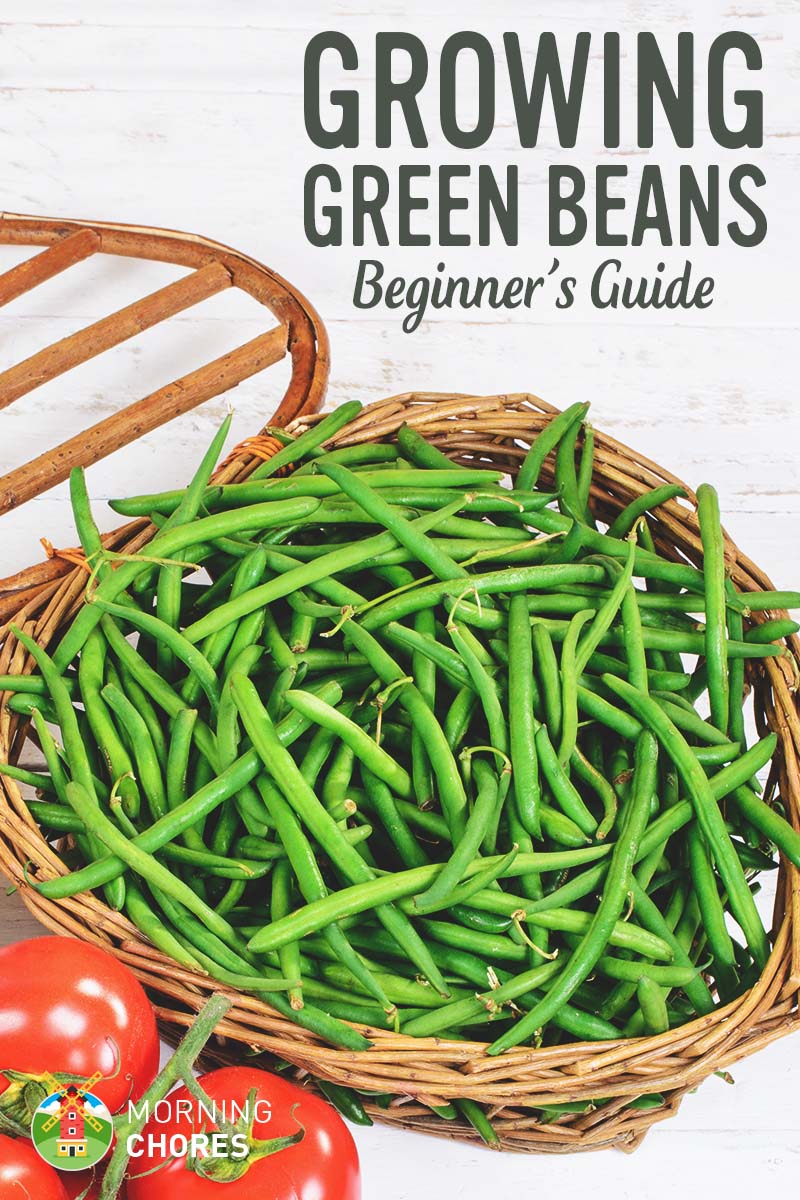
Did you know that every last Saturday in July, a Green Bean Festival is held in Blairsville, Georgia to honor the green bean? They have green bean cooking contests, a beauty pageant, and even a tour of the local canning plant.
Wow! Who knew that a green bean was that special to some people that they had a day just to celebrate them?
Well, if you love green beans even half as much as the folks around Blairsville, Georgia do then you are probably interested in all there is to know about growing green beans.
So today I’m going to give you the information you need to successfully grow green beans right outside your backdoor.
Let’s get moving…
Green Beans Plant Info
- Hardiness Zones : 3, 4, 5, 6, 7, 8, 9, 10
- Soil: Silty loam, sandy, PH between 5.5-7.5, well-drained, temperature between 15.5-29° Celsius
- Sun Exposure: Full sun exposure in well-drained soils
- Planting: Seeded directly in the garden when the soil temperature is at least 15.5° Celsius, 14-28 days before the last frost date and 80-133 days before the first frost date
- Spacing: 6-inches between plants for pole beans and 4-6-inches for bush beans, 12-inches between rows for pole beans and 4-6 inches for bush beans
- Depth: 1-2 inches seed planting depth
- Best Companions: Corn , potato , eggplant, cucumber , catnip, nasturtium, carrot, celery , tomato , peas , broccoli , beet , strawberry
- Worst Companions: Onion, scallion, leek, garlic , sunflower , pepper , basil, fennel
- Watering: Water moderately to ½-inch of water per week, avoid watering the plant tops
- Fertilizing: Apply a balanced fertilizer once a month throughout the growing season
- Common Problems: Bean weevil, stem nematodes, downy mildew, leaf and pod spot, chocolate spot, black bean aphid, bean seed beetle, bean rust, sclerotinia, cutworms, white mold, mosaic viruses
- Harvest: When the leaves are dry, before the seeds bulge, continual harvesting is recommended for prolonged production
The Varieties of Green Beans

There are 4 basic types of green beans. Within each type, there are different varieties to choose from.
1. Bush Beans
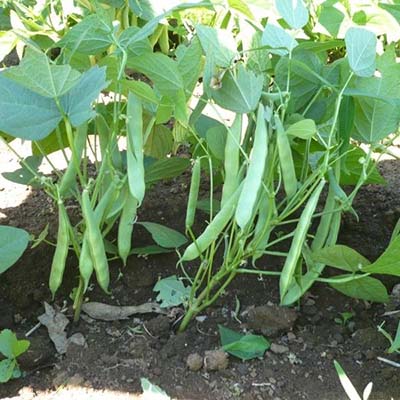
The first type of green bean is a bush bean. Bush beans are shorter beans that only grow to be about 2-feet in height.
However, they don’t require any trellises because if planted correctly they basically stretch out and lean on one another for support.
And an upside to growing bush beans is that they do produce about 1-2 weeks faster than pole beans though they don’t produce as much as pole beans do.
Also, bush beans have many popular varieties such as Contender, Blue Lake, Provider, and Tendergreen.
I must admit, we grow a variety of green beans in our garden, and bush beans are one of them. The reason we love bush beans is that you usually do not have to string them. The downside to bush beans is that they are very hard on your back when picking.
2. Pole Beans
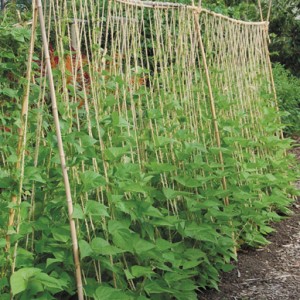
The second type of bean is pole beans. Now, these beans grow to be about 8-10-feet in height.
Even so, these beans certainly need a trellis because of how tall they grow. However, most people grow these beans on teepees.
They are obviously going to be much easier to harvest because they grow so tall, and they also are great producers as well. The varieties of these beans available are Rattlesnake, Fortex, and Kentucky Wonder.
3. Runner Beans
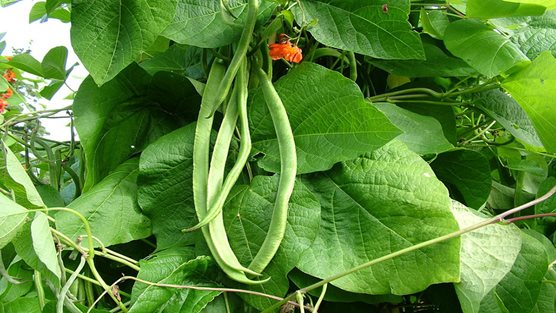
The third type of bean is a runner bean. These beans are great producers but take a lot of work while harvesting.
However, don’t let that deter you because though they are a lot of work at harvest, we still grow them because of how great their product is.
So the most popular variety of this type of bean is the Scarlett Runner. However, it is worth mentioning that if you do raise these beans that they will offer large pods though they do require stringing, and you will have to give them something to run-up.
4. Yardlong Beans
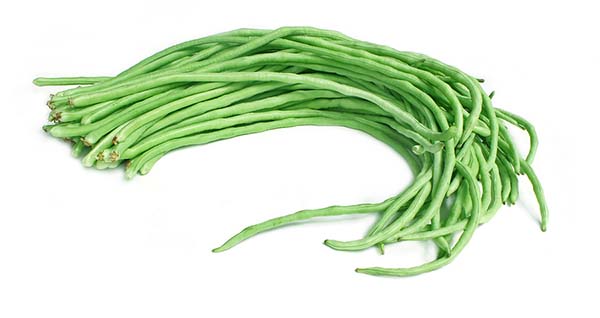
This type of bean is one that you may not be very familiar with. It is actually an Asian variety of green beans. They are most commonly found in Chinese markets.
The most popular variety of this bean is the Red Noodle. However, if you are interested in raising this type of bean you must live in a very warm climate. These beans need long hot summers (day and night) in order to thrive.
How To Plant Green Beans
Green beans give a large harvest for the amount of work that they require.
Here is the skinny on green beans. They can be planted once your ground temperatures are above 60°F. Not sure when that is going to be? No worries, just use this calculator .
Now that you know when you should plant them, you have already done half of the work in planting beans. Basically, you’ll add 1-2-inches of compost to the soil where you are planting them and plant them as seeds. Yes, they are direct sow. Isn’t that great?
However, it is worth mentioning that your soil pH level should be around 6.0-6.5. That is the acidity that makes them the happiest.
Then you will plant your seeds 2-4-inches deep. And be sure if you are planting a variety of bean that will need a trellis to do that before you actually plant your seeds.
And that is all there is to it. If you add the proper amount of compost to your soil you shouldn’t need to fertilize your beans any further after that. Beans are actually very light feeders so if you add too much nitrogen then you will cause a delay in their production.
When you go to plant them you can just dig a shallow ditch in the dirt with a trowel or a hoe . There are no fancy tools needed to plant green beans in your garden.
And that is just how easy green beans are to plant and become a part of your garden.
Common Problems in Green Beans
Green beans require very little care. All they ask for is 1-1.5-inches of water per week.
And they do better if you can water them through a drip irrigation system versus an overhead watering system and a garden hose . This is because dirt will not splash on them and helps them to avoid diseases from the dirt that splashes on them.
However, green beans do still have a few common ailments that you may come in contact with during your time growing them.
1. Stem Anthracnose
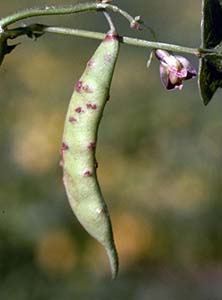
Stem Anthracnose is actually a fungus. You will know your plants have it if you begin to see dark colored spots on them. This actually forms from your beans growing in overly wet conditions.
You will be able to avoid this fungus by avoiding overhead watering. This keeps the dirt off of your plant and, in turn, avoids the fungus from latching on to your beans. Unfortunately, there are no treatments known at this time.
2. Bean Rust
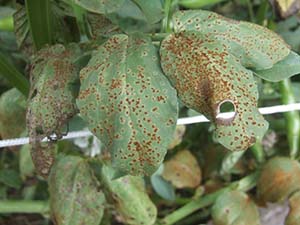
Bean rust is also a fungus. You will know your plants have developed this disease because it will have developed rust-colored spots.
Again, the only way to beat this fungus is to stop it before it starts. You can accomplish this by rotating your crops. Unfortunately, if your plants do develop this disease you will need to discard them.
3. Mosaic Virus
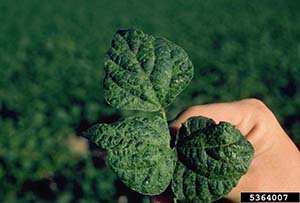
Mosaic viruses are caused by many factors such as herbicide use, infections, or nutrient deficiencies. You will know your plants have this disease if they have unusual colored splotches on them. Like many of the other diseases, the only real way to beat them is to discard once your plants develop the disease.
4. Powdery Mildew
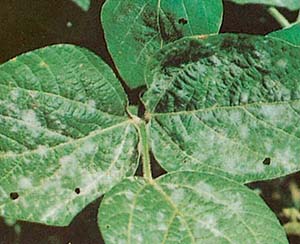
Powdery mildew looks like it sounds. It is basically a white powdery film that develops on your plants. It is spread by wind and rain.
The only way to beat or avoid this disease is to avoid overhead watering, use high-quality seeds when planting, and also to use a fungicide if your plants develop this disease.
Best Green Beans Companions
Companion planting is a great method to keep in mind when planting a garden. The reason is that there are certain plants that complement each other well when planted near each other. They are able to give each other a boost that they simply can’t get when planted near other plants.
However, with that same thought process, there are also plants that should avoid each other in the garden. They drag one another down by drawing the same bugs and other common problems that could equate to a disaster for both crops.
Well, green beans are no different. They have friends and foes in the garden. So what are they? Here they are…
Best Companions for Green Beans:
- Cauliflower
- Summer Savory
Worst Companions:
Harvesting and storing green beans.
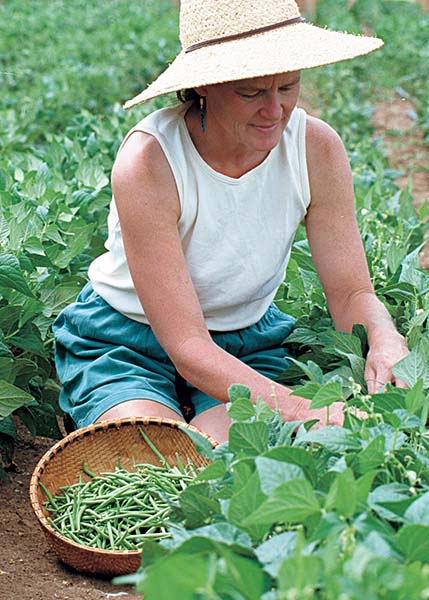
So you’ve planted your green beans and now they are producing like crazy. However, now what?
Well, the fun is just beginning. Green beans are fairly easy to make grow but the harvesting is where the real work begins.
When you harvest your green beans is going to depend on your personal preference. Around my house, I have some picky green bean eaters. When green beans are still young and tender is when I have to pick them if I expect my husband and boys to eat them.
See, as green beans get bigger and the beans fill out, the strings become more prominent and the outside of the pod gets a little tougher.
Now, some people love this type of bean commonly called a ‘shelly.’ However, not around my house. If my husband or boys have tougher skin or see a string then they pretty much turn their noses up.
As I said, I pick my beans when the inner bean is still very small. Basically, when they are young and tender.
However, as I was saying, you look at your beans and decide your own preference as to when you want to harvest.
And after you decide to harvest you just go along the row or teepee and gently pluck them from the plant. Once they have been picked you’ll bring them inside and rinse them.
Then my favorite part begins. You grab a large pot and a pan. You’ll need the pot to put the broken beans in and a smaller pan to hold handfuls of green beans in your lap. I usually put on a movie while I’m breaking beans so I can relax and be productive simultaneously.
When you are set up you will break one end of the bean and pull the string down the side of the pod. (Unless you went with stringless beans. If that’s the case you’ll just break off both ends of the bean.)
You’ll then break the other end of the bean and pull the other side’s string off. Then you will break the bean into 2 or 3 parts. Then toss them in the pot. And do this repeatedly until the whole harvest has been strung and broken.
After stringing is complete, you’ll wash the beans again in cold water to make sure there is no remaining dirt on them. Then it will be time to store them.
Storage Options
1. into the fridge.
If you don’t have time to string your beans right after harvesting, no worries. All you need to do is leave the beans unwashed and place them in a storage bag or a grocery bag.
Then you’ll toss them in the fridge. They should remain in good shape for up to 7 days. And then you’ll process them as mentioned above when you are ready.
2. Into the Freezer
Many people actually do not recommend freezing your fresh green beans. Apparently, there have been some studies that show that green beans begin to lose certain nutritional value after being stored in the freezer between 3 and 6 months.
However, if you would still like to freeze them then after you process them as mentioned above, you will steam them for 2-3 minutes. Then place them in a freezer sealed bag and toss them in the freezer until you are ready to eat.
3. Into the Canner
I usually can most of my green beans. So after you process them and wash them the second time you will tightly pack the raw beans into washed and sanitized quart jars. You will also need to place 1 teaspoon of canning salt in the bottom of the jar.
After the jars are tightly packed, you’ll want to fill the jars with water up to the neck of the jar. Then place a fresh lid and a ring on to the jar. Then you will pressure can the beans for 25 minutes under 10 pounds of pressure. If you are unfamiliar with canning, here is a great resource :
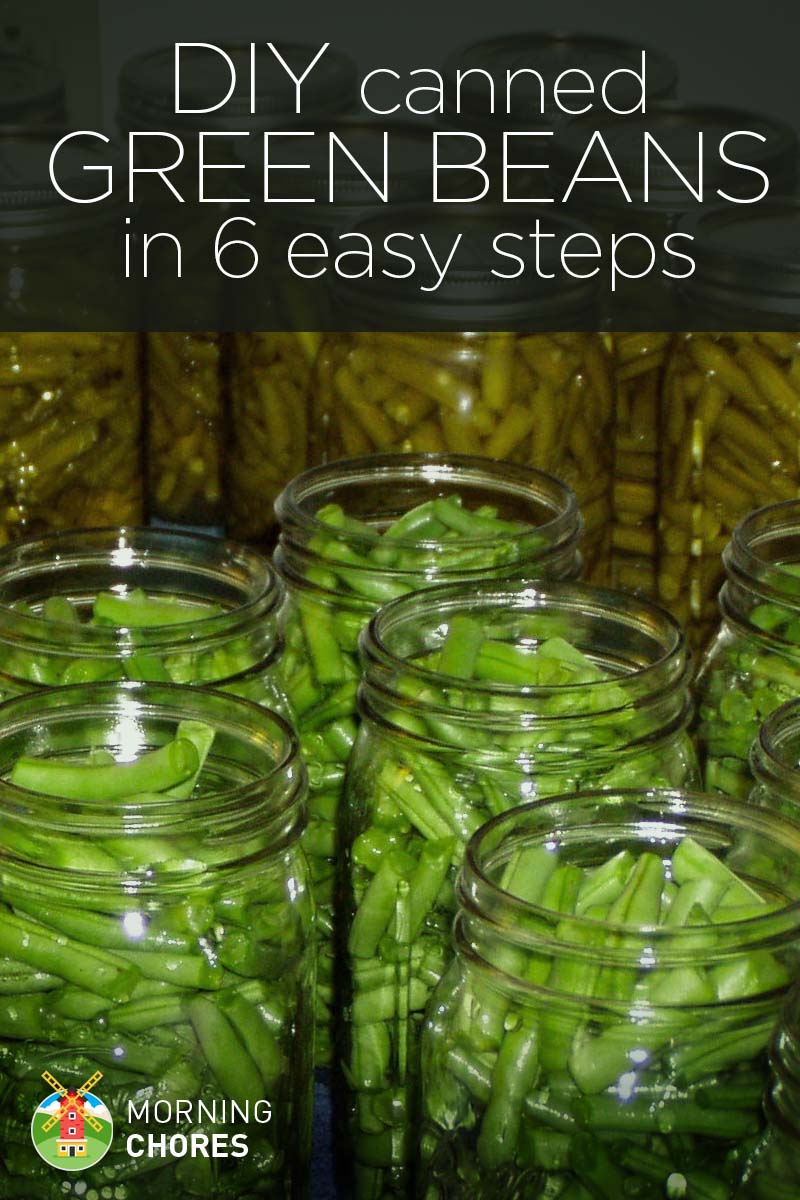
4. Into the Stomach
So you picked and processed your beans. However, you don’t want to store them for later. You want to eat them now ! I understand. Fresh green beans are so delicious.
After you wash the beans for the second time you will place them in a pot where they are covered with water.
Now, I like a lot of flavor in my beans. So instead of just boiling them in the water, I add some stock or bullion to the water. I also add some fresh onion or onion flakes. As well as red pepper flakes, bacon, or bacon bits to the mix.
Then you will bring them to a boil and then allow them to simmer for about 1-2 hours until they are tender. Then you can add some butter to the finished product. They are so good!
As you can tell there are multiple ways to store your fresh green beans and harvesting isn’t very difficult either. Green beans are truly a great plant to have in your garden.
Recipes for Your Green Bean Harvest
When you grow green beans, harvest them, and store them you have to know what to do with them once you have them ready for your consumption. So here are a few recipes to help you get started.
1. Green Bean Casserole
Green bean casserole is a favorite around many households. It is a delicious way to help your family have a little different twist on the traditional form of cooked green beans.
2. Dilly Beans
Dilly beans are a delicious option for fresh grown green beans. When you get tired of canning regular green beans then you can always can these for a different twist.
3. Green Beans with New Potatoes
This recipe is great for a Sunday supper with the family all gathered around your kitchen table. It is very frugal and rather simple to put together. So if you need a dish that is delicious and will feed many then this recipe is for you.
4. Vegetable Soup
I love vegetable soup. I could seriously eat it on a hot summer day. It is healthy and delicious. If you would like a tasty soup that will warm you up on a cold winter day or fill your stomach on a warmer day then you will love this one .
5. Fried Green Beans
This is a different recipe for green beans. However, it sure looks tasty. If you are a fan of fried green tomatoes then you will probably love fried green beans too. Give it a try with this recipe .
There you have it, folks. All you need to know about growing your very own green beans. They are very tasty, easy to grow, and great nutrition for you and your loved ones.
So why not go for it and raise your own?
Was this article helpful?
What went wrong.
This article contains incorrect information
This article does not have the information I am looking for
How can we improve it?
We appreciate your helpful feedback.
Your answer will be used to improve our content. The more feedback you give us, the better our pages can be.
Follow us on social media:
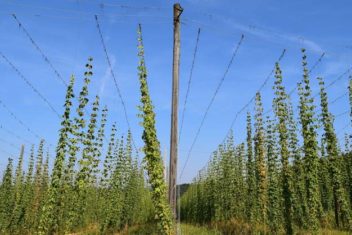
Growing Hops: The Complete Guide to Plant, Care, & Harvest Hops
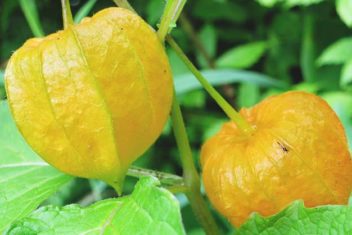
Growing Ground Cherries: How to Plant, Care, and Harvest Ground Cherries

Growing Sunflowers: Varieties, Planting Guide, Care, Problems, and Harvest
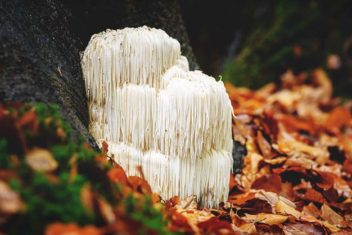
How to Grow Lion’s Mane Mushrooms on Logs and Sawdust

Growing Satsumas: The Ultimate Care Guide for This Citrus Delight
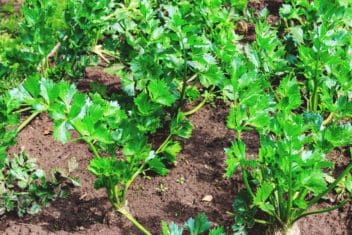
Growing Celery: Best Varieties, Planting Guide, Care, Problems, and Harvest
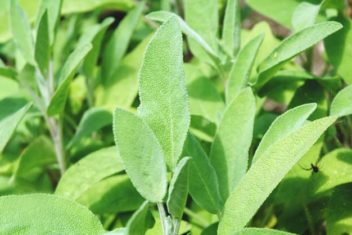
Growing Sage: The Complete Guide to Plant, Grow, and Harvest Sage
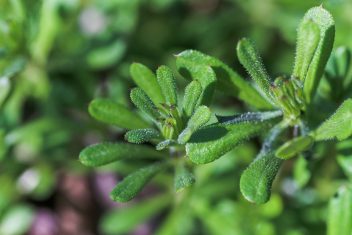
Goosegrass: How to Plant and Use This Beneficial “Weed”
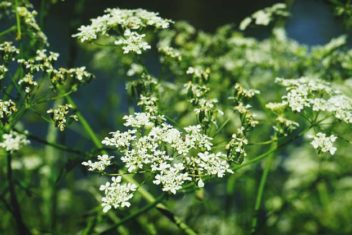
Growing Caraway: The Complete Guide to Plant, Grow and Harvest Caraway
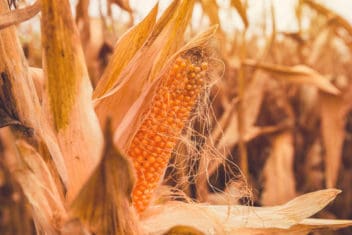
How to Grow Popcorn Plant in Your Garden


Growing Hawthorns: How to Plant and Raise Crateagus Trees
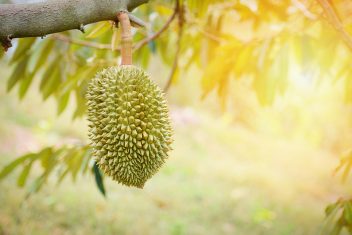
Growing Durian Tree: How to Raise This Incredibly Unique Fruit

Homegrown goodness: why we should all be eating more broad beans
Tesco is on a mission to get the nation to eat more legumes. Seasonal foodie Gem Morson and clinical nutritionist Nishtha Patel explain why they’re on board
Go back in time as far as the iron age, and you’d find our ancestors eating broad beans. For centuries, the legumes were a crucial part of the British diet, until they fell out of fashion. Recently, however, they’ve been cropping up in an increasing number of recipes from some of the country’s most exciting chefs and food influencers.
Gem Morson, AKA the Mother Cooker , is on a mission to help us eat more seasonally. “Broad beans are a fantastic ingredient,” she says. “They’re packed with protein, fibre, vitamins and minerals, plus they’re grown in Britain. And because they’re available when they’re in season, they taste so much better, too.”
The large, flat, bright green beans produced by certain varieties of the vicia faba (fava bean) plant are one of the oldest cultivated crops in the UK. Creamy, nutty, buttery and slightly sweet, they are picked and eaten fresh in late spring, and they’re a vegetable that freezes well too.
As the UK’s largest supermarket, Tesco is helping customers make better choices when they shop by highlighting better foods, such as snacks containing under 100 calories or foods that are high in fibre or low in sugar, through its Better Baskets campaign .

Sales of frozen broad beans have increased by more than 10% in the last year, as customers affected by the cost of living crisis look for ways to make their budgets go further. “At £1.60 for a big bag, they’re affordable, just as nutritious as fresh and very convenient – they cook in five minutes from frozen and there’s no waste because the rest of the bag can be popped back into the freezer,” says James O’Neill, buying manager at Tesco.
The fresh variety, on the other hand, is seen as a “premium” product, and has suffered a slight decline in sales in recent years. “Historically, customers choosing fresh broad beans have tended to be older, as they would have grown up eating more seasonal British produce,” says Lisa Gilbey, buying manager at Tesco.
The retailer is hoping to change that by highlighting the beans’ many benefits. One of which is that they “are great for soils and humans alike”, in the words of Caroline Green, a director at AS Green, the family-run, Malvern-based farming business, which grows them for Tesco. Like other legumes, broad beans have nitrogen-fixing bacteria in their root systems, enriching the soil rather than depleting it.
For Morson, they’re the perfect example of a British-grown vegetable that we often overlook in favour of more exotic options, but which can be used in a wide variety of exciting ways. “They’re great in a fresh, creamy risotto, or blended and made into a lighter version of hummus, or smashed with lemon juice and garlic on toast, with some crumbled feta on top,” she says. “They’re also excellent thrown into soups and stews, adding protein and fibre and making them more hearty and filling.”
She recommends double podding them – removing the pod and also the skin of the individual beans: “Blanch them for two minutes, drain and cool them under cold water and use your nail to slit the skin and pop them out. It takes a little bit of time, but it’s worth it to make them more tender and delicious.”
Nishtha Patel, known as the Gut Expert, is also a fan. A clinical nutritionist who works with clients to tackle disorders including IBS, colitis and autoimmune disease, she is renowned for her tips on how we can optimise our gut health. We’re all increasingly aware of the importance of our microbiome – the ecosystem of microbes that live in our intestines – and Patel says: “With their abundant fibre content, broad beans work wonders for digestive health, promoting the growth of vital friendly gut bacteria.”

Unlike some legumes, broad beans are low in Fodmaps: types of carbohydrates that can be poorly absorbed in the small intestine and fermented by bacteria in the large intestine, leading to bloating, gas, and abdominal pain, particularly in people with IBS. “They are a great choice for those with sensitive stomachs,” she says. “Thanks to their complex carbohydrates, they also provide a steady supply of energy throughout the day, without any dreaded energy crashes.”
Patel often cooks them in stir-fries, serves them simply steamed or uses them in curries, with garlic, cumin and tomatoes. “And I love them as a crispy snack, using fresh or thawed frozen beans tossed with olive oil, garlic powder, paprika, salt and pepper, then baked at 200C for 20 to 25 minutes. They make a delicious and nutritious snack or a crunchy topping for salads or soups,” she says.
Morson hopes the comeback of broad beans will continue apace, with more people rediscovering native-grown vegetables. “Once you realise how much better food tastes when you eat it in season, it’s a gamechanger,” she says.
Find out more about how Tesco is working to improve the health of the nation at tesco.com/better-baskets
- Better Baskets
- advertisement features
- Save your essays here so you can locate them quickly!
- Essential Nutrient
- Health Insurance
- New England
All About Green Beans Bibliography 3 Pages 793 Words
Most people never consider all the facts about the food they eat, especially if it's something they know is probably good for them, like vegetables. One of those vegetables is green beans. Have you ever thought about green beans, I mean really though, I know I have not? Although not a lot of thought is put into what green beans are or where they came from, those facts are interesting to know. This paper will discuss the origin and evolution of green beans, the cultures they are used in, their uses, nutritional value, and health benefits or risks. Beginning with the origin and evolution, it is estimated that green beans were first grown about 7,000 years ago by Indian tribes in the Tehuacan Valley of Mexico and in Callejon de Huaylas, Peru. The beans were domesticated independently in different areas from a common wild ancestor. These separate domestications led to the development of the different colored beans. For example, light-colored, small-seeded varieties developed in Mexico and dark-colored, large-seeded varieties in Peru. They gradually spread throughout the Americas by migrating bands of Indians. By the time the British colonists arrived in the 17th century, they found Indians growing beans in New England and Virginia. The beans were then spread throughout the world by the Portuguese and Spanish explores. They became important crops in Africa, Asia, and Europe (F.N. Encyclopedia 1:172-173). Now green beans are produced and used by many cultures around the world. One interesting fact is that the Chinese produce the greenest beans in the world. Other countries that produce green beans, in order of greatest production include Turkey, Spain, Italy, France, Egypt, the U.S.A., Romania, Japan, and Indonesia (F.N. Encyclopedia 1: 173). Since we know where green is produced, how are they used? Green beans may be used and prepared in several different ways. They may be canned, used in casseroles, stews, soups, or as a simple side di...
Continue reading this essay Continue reading
Page 1 of 3
More Essays:
- Web Stories
- Food Trails
- Cocktail Sifter
- Photo Stories
8 Health Benefits Of Green Beans You Should Explore
Rich in protein, fibre, iron, and vitamins, beans are a powerful plant-based source that has numerous health advantages. Beans may benefit a person's liver, stomach, and heart health. Continue reading to discover more amazing facts about beans backed-up by science.

When was the last time your mother made you eat all of your vegetables? You'll be pleased with all the positive health effects of green beans if your mother enjoyed cooking them and you paid attention to her advice.
Although green beans are grown all across the world now, they appear to have originated in Peru about 7,000 years ago. While the United States also produces a significant amount of green beans, Indonesia, India, and China are some of the leading producers of green beans.
As one of the healthiest foods strong in antioxidants on the planet, green beans are a powerful addition to any healing diet, helping to avoid a host of problems and maintaining the health of your digestive system.
Green beans, in contrast to many other green vegetables, can even be frozen while retaining their nutritional content. Although they are deemed to be "in season" and at their most affordable from summer to early fall, they are also incredibly popular and year-round available at your neighbourhood farmers market or grocery shop.

Take a look at these facts from research and data of NIH and USDA .
8 Green Beans Health Benefits
1. Green Beans Aid In Cancer Prevention
Consuming beans has been associated with a decreased risk of breast cancer in general. The high fibre content of the beans may be the cause of this. Consuming a lot of green beans can also lower your risk of colon cancer. These beans are a great source of many bioactive components that can help prevent cancer. Green beans include non-digestible carbohydrates that are fermented by gut flora, which has anti-inflammatory effects. In addition, the low glycemic index of these beans has been linked to a lower risk of cancer. Green beans have anti-carcinogenic qualities due to the presence of saponins, phytosterols, and gamma-tocopherol.

2. Green Beans Encourages Heart Health
Consuming greens has been associated with a lower risk of heart attacks. Beans' fibre and folate content is responsible for this. Additionally, they contain vitamin B12, which works in concert to lower plasma homocysteine levels. One specific amino acid that is found in the body and whose increased levels have been connected to heart disease is homocysteine. Along with lowering blood pressure and cholesterol, the fibre in green beans and other vegetables can also improve blood vessel health. This may always be beneficial to heart health.

3. Beans Aid In Diabetes Management
Research indicates that green beans can have positive metabolic benefits for diabetics. While most veggies are nutritious, those who have diabetes may want to avoid ones with higher starch content. Green beans have a low starch content, making them non starchy. These are a great complement to a diabetic diet because they have less carbohydrates. Combining a low-glycemic diet with a cup of beans every day can help diabetics reduce their risk of heart disease and even their blood sugar levels.

4. Green Beans Enhances Digestive Health
Constipation and inadequate fibre intake are frequently associated. Additionally, fibre improves gastrointestinal health in general. Both soluble and insoluble fibre are often found in beans, with the insoluble form making up the majority (75%). This kind of fibre passes through your digestive tract quickly. This aids in the prevention of the majority of digestive cancer types in addition to supporting a healthy digestive tract. Eating green beans may also aid in the management of irritable bowel syndrome symptoms. This is explained by the beans' high fibre content.

5. Could Strengthen Bones
Overall, beans are an excellent provider of calcium. Calcium can reduce the risk of osteoporosis. Additionally, green beans are high in vitamin K, another nutrient necessary for strong bones. In this sense, the phytate concentration of beans is the only potential drawback. Beans include compounds called phytates that may make it more difficult for the body to absorb some nutrients, such as calcium. Put differently, phytates oppose nutrition. If you soak the beans in water for a few hours before cooking them in water, you can lower the amount of phytate in the beans.
Read More: 7 Benefits Of Overnight Cold Tea Brews And Why You Should Have It Regularly
6. Could Potentially Enhance Vision
Are green beans healthy for someone with eyesight impairments? Indeed, lutein and zeaxanthin, two significant antioxidants that support healthy vision, are abundant in green beans. Research demonstrates how these nutrients can stave against cataracts and age-related macular degeneration. For those who may be genetically prone to AMD, increasing their diet of lutein and zeaxanthin can also help prevent the condition. Green beans include lutein and zeaxanthin, which may contribute to an increase in the macular pigment's optical density and cause these effects.
7. Eating Green Beans Reduces Depression
Consuming fruits and vegetables has been linked to a decreased chance of developing depression in general. B and C vitamins, which are abundant in green beans, are known to support mental wellness. Eating fresh fruits and vegetables was found to have a greater impact on these outcomes. Additionally, high in magnesium, zinc, and the amino acids tyrosine and glutamine are beans in general. It has been discovered that all of these improve mental wellness via increasing neurotransmitter synthesis.
8. Might Be Helpful in Pregnancy
Folate, a vitamin that is vital during pregnancy, is abundant in green beans. The human body produces red blood cells as a result of folate intake. It also contributes to the development of the embryo's nervous system. Sufficient folate lowers a baby's chance of neural tube abnormalities. Broadly speaking, beans are among the healthiest foods available. Rich in essential nutrients, green beans are a nutritious way to add colour to your food.
Green beans can be prepared in a variety of ways. You can eat them on their own or add them to soups, stews, and salads. They can also be added with meat and poultry. To maintain their nutritional value, it is preferable to consume them whole rather than chopped.

Popular Articles
Related articles.
- Search Please fill out this field.
- Martha's Blog
- Newsletters
- Sweepstakes
- Holiday Planning & Ideas
- Thanksgiving
Here's Why We Eat Green Bean Casserole at Thanksgiving
This holiday favorite was created in 1955 by a home economist working in the Campbell Soup Company test kitchen.
Aimee is a freelance writer for MarthaStewart.com.
:max_bytes(150000):strip_icc():format(webp)/aimee-lee-ball-LA-0217-df393acd3b7145ba96f6937f0d73ccb9.jpg)
When dreaming up your Thanksgiving dinner menu , there is one dish you likely can't imagine your meal without: Green bean casserole . The quintessential side has joined the ranks of turkey day mainstays, like cranberry sauce and stuffing, solidifying itself as a holiday favorite. But beyond being easy to make (you need little more than green beans, mushrooms, and shallots), have you ever wondered why green bean casserole has become a Thanksgiving tradition? Believe it or not, there's a historical reason we eat the dish during the harvest season.
How Green Bean Casserole Was Created
In the early to mid-20th century, cooking schools and cookbook authors encouraged the serving of red or green foods for Christmas. It was the heyday of maraschino cherries and lurid Jell-O molds. In 1955, a new green classic was created at the Campbell Soup Company: Green bean casserole. Despite this fact, green beans weren't actually the initial inspiration behind the dish at all. The casserole was invented when Dorcas Reilly, a home economist at the company's test kitchen in Camden, N.J., was asked to create a dish utilizing condensed cream of mushroom soup.
After a few initial experiments (including rolled ham and celery salt), Reilly decided to try green beans—a staple in many American homes at the time. Thus the final casserole, called the Green Bean Bake, was created. The original recipe called for six ingredients, including cream of mushroom soup, green beans, milk, soy sauce, pepper, and French's French Fried Onions.
How It Became a Holiday Staple
Green bean casserole was considered a perfect dish for holiday entertaining because it was simple, inexpensive, and could easily be made ahead of time. It became known as a "jiffy casserole" because it went from one bowl to one pan. "Casseroles bound with white sauces became especially prevalent during the Depression as a way of stretching ingredients," says Cathy Kaufman, president of the Culinary Historians of New York . "Luxurious versions are colonial, but it does seem that the convenience of frozen green beans brought this recipe to the forefront in that age of convenience cookery."
Still a Thanksgiving Favorite
Campbell's estimates that 30 percent of the cream of mushroom soup sold in the United States today still goes into making this nostalgic, retro casserole. Although the classic recipe is considered sacrosanct by many families and has often appeared on soup can labels since 1963, Campbell's has created almost a dozen modern variations, including one with Dijon mustard and a Green Bean Casserole Italiano.
A copy of the original recipe, which Reilly wrote on an 8-by-11-inch card, was donated to the archives of the National Inventors Hall of Fame in Ohio on November 19, 2002. The card was followed by a Thanksgiving meal featuring the casserole.
Related Articles
WANT MORE RECIPES?
A Kind-of-a-Big-Deal Green Bean Sandwich
It’s September 1 and I’m officially over it.
It’s still 80 degrees and 75 percent humidity by 8:00 am. The caterpillars ate all my parsley and the basil withered while we were in the Pacific Northwest for a week.
The cats look equally wilted and tragic no matter how often I run our wheezy window air conditioner. Quarterly taxes are due.
I’m turning the oven on again because that long list of fall recipe assignments aren’t going to make and test themselves. Even my Japanese cat game is starting to bore me.
In short, I’m burned out. I’m not sure what is going to cure me of this malaise apart from another vacation (good thing we’re headed back to the West Coast in a few weeks), but in the meantime, I’ll eat the pain away
While we were in Portland, I found my salvation during another “over it” moment at Meat Cheese Bread .
To be fair, I probably shouldn’t have eaten only a Blue Star donut and a (very strong) iced coffee for breakfast, but by 2:00 pm, it was too late, we were too frustrated by traffic as we tracked down various local inspirations for The Simpsons and Grimm filming locations , and I was too, too hangry for words.
The green bean sandwich–such an odd yet comforting mishmash of ingredients–sounded light enough to get me through as a snack until dinner, but it arrived as a hot, dripping behemoth of a meal.
Blistered green beans came tucked into a long, toasty roll, the bread soaking up the grease and salt of what the menu called “bacon relish” and a thick layer of aioli, compounded by creamy slices of egg yolk and thick shavings of Parmesan.
It was hearty. It was salty. It was like eating the contents of an entire picnic table potluck between your hands.
In fact, it was so surprisingly filling that it induced something I’m now calling “sandwich regret,” where you are compelled to eat the entire thing–despite the warning, creeping pangs of an overstuffed belly–because something this warm and drippy and messy just won’t keep for leftovers.
I’ve felt the same sandwich regret when making it at home, and I still eat everything on my plate because it’s just too good in the moment.
Though I’ve contemplated turning the sandwich into a panzanella/nicoise combination salad, it’s just not as satisfying to eat these ingredients out of a bowl with a fork as it is to clutch it between your hands and dig in.
If your grill has a side burner, you can make the whole thing outside and save yourself the pain of heating up your kitchen–and giving everything you’re wearing the smell of griddled food and sizzling fat, like one does when leaving the warm and aromatic conditions at Meat Cheese Bread.
Whatever gets you through at this point.
Green Bean Sandwich with Bacon Aioli
This green bean sandwich is much heartier than it sounds, with gut-busting layers of charred green beans, bacon aioli, hard-boiled eggs, and freshly shredded Parmesan.
Ingredients
- 3 thick strips bacon, roughly chopped
- 1 large shallot, minced
- 1 large garlic clove, minced
- 1 tablespoon apple cider vinegar or red wine vinegar
- 1 tablespoon mayonnaise
- 3/4 pound (12 ounces) green beans, trimmed
- 1 teaspoon olive oil
- 2 hard-boiled eggs
- 3-4 tablespoons coarsely shredded or shaved Parmesan cheese
- 2 crusty rolls, such as mini ciabatta rolls
Instructions
Prep the ingredients:.
- Add the bacon to a large, heavy pan like a cast iron skillet. Place over medium-high heat and cook, stirring occasionally, until the bacon has rendered most of its fat and is almost fully crisped.
- Stir in the shallot and garlic and cook just until the shallot is tender and the bacon is completely crispy.
- Scrape everything in the skillet, including the drippings, into a bowl. Stir in the vinegar and mayonnaise and set aside.
- Place the pan back over the heat.
- Toss the green beans with the olive oil and add to the pan in a single layer. (You may have to do this in 2 batches if your pan's not big enough.)
- Cook until the beans are blistered and charred, then transfer to a bowl and repeat with the remaining beans. Alternatively, you can char the green beans on a preheated grill in a veggie basket.
Assemble the sandwiches:
- Split and lightly toast the rolls.
- Slather the cut sides of each roll with the bacon aioli.
- Pile the green beans onto each roll, gently pressing them into the bread and arranging them with your hands.
- Slice the eggs and fan them across the green beans.
- Lavishly sprinkle the Parmesan over the eggs.
- Close the sandwiches, cut them in half if desired, and chow down.
- Commence sandwich regret.
Nutrition Information:
The nutritional information above is computer-generated and only an estimate.
Did you make this recipe?
Share a photo!
FTC Disclosure: As an Amazon Associate, I earn from qualifying purchases. Good Food Stories LLC receives a minuscule commission on all purchases made through Amazon links in our posts.
Casey Barber
Casey Barber is the owner and founder of Good Food Stories LLC and a visual storyteller whose work often focuses on the intersection of food and culture. She is also the author of the cookbooks Pierogi Love: New Takes on an Old-World Comfort Food and Classic Snacks Made from Scratch: 70 Homemade Versions of Your Favorite Brand-Name Treats , and she couldn’t get anything done without the help of her executive assistant cats, Bixby and Lenny. Her favorite color is obviously orange.
Similar Posts
Beyond Canning + Tomato-Vanilla Jam
Good Luck Pork and Sauerkraut
Collard Caesar Dip: Who Needs Salad, Anyway?
Ask Casey: Large Eggs vs. Extra Large Eggs
Goat Cheese Sour Cherry Ice Cream
Vanilla Ice Cream + How to Make Custard
Leave a reply cancel reply.
You must be logged in to post a comment.

Green Bean Casserole
- Write a Review
- Ask a Question
- Save Recipe
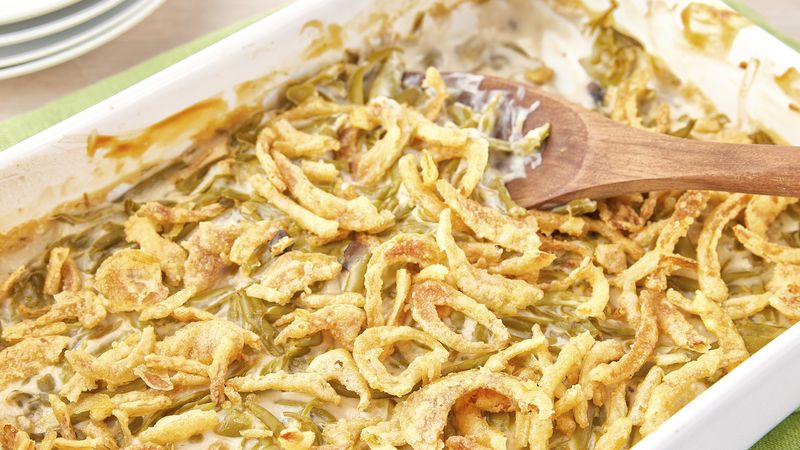
- Total 30 min
- Keep Screen On
What Are the Best Green Beans to Use in Green Bean Casserole?
For this easy green bean casserole, we call for canned French-style green beans because they require the least amount of attention, making this recipe super simple to make, no matter what your kitchen skills are. If you’d rather use frozen green beans, you can use frozen French-style, cut or whole green beans, but for the best green bean casserole, be sure check out the recipe variation, which gives complete instructions on how to prep them before adding them to the other ingredients, so they will be tender when the casserole is baked. We don’t recommend fresh green beans for this recipe, because you’d have to cook them first (requiring 8 to 20 minutes of additional cooking and after all that effort, they still may come out stringy and tough after baking.
What Should I Eat with Green Bean Casserole?
This classic green bean casserole is so versatile, It's the perfect partner at just about any meal! Holiday Feasts: it can go with any holiday meal, whether you’re serving turkey, ham, beef or even lasagna! Try it with our company-worthy ham for Easter or turkey recipe for Thanksgiving or Christmas and wait for the oohs and ahhs. Weeknight Dinners: Don’t just think of string bean casserole as a holiday dish—it’s so quick and easy, it’s perfect for weeknight dinners, too! Serve it with your favorite baked or grilled chicken, pan-fried pork chops or alongside your favorite spaghetti dinner. Make It the Main Event: You can even turn it into a main dish with this delicious ham and cheese green bean casserole recipe! Or try adding pepperoni, chopped cooked chicken or leftover chopped roast beef. Delicious!
How Can I Store and Reheat Green Bean Casserole?
If you’re lucky enough to have any leftovers, Green Bean Casserole is delicious when reheated! Just know that the fried onions won’t be crisp after being stored. But that’s ok--simply sprinkle the casserole with a few more after heating. It will be a comforting addition to any lunch or leftovers dinner night. Fridge: Follow the make-ahead directions in our FAQ below. Cover leftovers with plastic wrap and refrigerate any leftovers immediately after the meal. Reheat: To reheat green bean casserole, spoon the casserole into a microwavable dish. Cover loosely with plastic wrap. Reheat on medium-high (70%) until thoroughly heated. The onions will no longer be crispy. You can sprinkle additional crispy fried onions before enjoying. Freeze: We do not recommend freezing green bean casserole, as the beans will become mushy when baked and the casserole can become watery.
Ingredients
- 2 cans (14.5 oz each) French-style green beans, drained
- 1 can (10.5 oz) condensed cream of mushroom soup
- 1/4 cup milk
- 1 container (2.8 oz) crispy fried onions

- 3 ALTERNATE METHOD: Heat oven to 325°F. In 1 1/2-quart casserole or glass baking dish, mix green beans, soup and milk. Bake 25 to 30 minutes, topping with onions during last 5 minutes of baking, until bubbly.
Tips from the Betty Crocker Kitchens
- tip 1 To make sure your baking dish holds 1.5 quarts (6 cups), use a liquid measuring cup to pour water into the dish until it's full. There should be enough room for the green beans to not completely fill the dish.
- tip 2 Green Bean Casserole with Frozen Green Beans: Frozen French-style green beans can be substituted for the canned beans. Give frozen beans a quick rinse under cool water in a colander and shake off excess water before mixing with the soup and milk. Alternatively, 2 bags (1 lb each) frozen cut or whole green beans can be substituted. Cook as directed on bag for minimum time. Drain; stir into soup mixture. If prepping ahead of time, cover tightly and store overnight in refrigerator before baking. In Step 2, bake about 30 minutes or until beans are tender.
Frequently Asked Questions
Can you make green bean casserole ahead of time.
Have an event or gathering coming up tomorrow? Your easy Green Bean Casserole can be assembled early to save time! Once you’ve assembled your Green Bean Casserole (be sure to leave off the onions), cover and refrigerate it until you’re ready to bake it the next day. Make sure to add a few extra minutes of baking time to account for the coldness of the chilled casserole before adding the onions in Step 2. This is a crowd-pleasing best green bean casserole without any of the fuss! Craving other great side dishes? Try one of our favorites-- scalloped potatoes or bread stuffing . Looking for other ideas for your holiday spread? We’ve got yummy recipes you can mix or match with your holiday main dish and green bean casserole. Pull together an outstanding menu with these Thanksgiving side dishes or Easter side dishes .
What are other variations of this recipe?
While the basic recipe is always devoured, you can mix it up with a flavor twist or two, so that no one ever tires of enjoying this popular side dish throughout the year. Try one of these scrumptious ways to hack green bean casserole, depending on your tastes or what you have in your cupboard. Substitute Other Condensed Soups: You can substitute your favorite cream-style condensed canned soup for the cream of mushroom soup, such as celery or cream of chicken. Additional Seasoning: For additional flavor, add 1/4 teaspoon garlic or celery powder or ground pepper. Chopped Vegetables: Stir in 2 tablespoons finely chopped sun-dried tomatoes in oil (drained) or diced pimientos (drained) with the green beans. Other Additions: Instead of the crispy fried onions, try some crumbled crisply cooked bacon, crushed seasoned croutons, nacho-flavored tortilla chips, buttery crackers, or sliced or slivered almonds over your Green Bean Casserole right before serving.
How Do You Keep Green Bean Casserole from Getting Soggy?
Use these simple tips to have green bean casserole that has the perfect creamy sauce and crunchy fried onion topping: Start with canned green beans that have been drained or frozen green beans that have been cooked and drained (see the variation above). Any liquid from the beans will make your casserole watery. Only add 1/4 cup milk with the condensed soup—do not add the water as directed on the can. Add the crispy fried onions during the last 5 minutes of baking or they will absorb some of the sauce and become soggy. The onions will absorb sauce as they sit or if there are leftovers, when stored in the refrigerator. Bake the casserole just before serving it. When reheating leftovers, the onions will still add their flavor to the dish, but if you like the crisp texture on top, simply top the reheated casserole with additional onions right before serving.
Nutrition Facts
Serving size: 1 serving, % daily value*:, carbohydrate choice, more about this recipe.
- What is it about green bean casserole that makes it special every meal it shows up on the table? It is a Thanksgiving or Easter tradition for many families…one of those memory-making recipes that gets passed down, so the tradition continues! Our green bean casserole is so easy to make, you can have it at every holiday. It’s not likely you will have leftovers of this recipe, but if you do, follow the storage and reheating guidance above. Wondering how to creatively use up your holiday leftovers? These amazing recipes use up those foods in new dishes your family will love.
Try These Next

Explore Categories
- Green Bean Recipes
- Fresh Green Bean Recipes
- Vegetable Casserole Recipes
.png)
BACK TO NEIGHBORHOOD READS

- Oct 17, 2021
“The Anthropocene Reviewed: Essays on a Human-Centered Planet" | Reviewed by Pat Sainz
Updated: Oct 21, 2021
“The Anthropocene Reviewed,” by John Green is a series of essays about a variety of subjects that have influenced Green in some way over the years. He reflects on 44 topics in short chapters, ending each with a 1-5 star review, a popular rating form for just about everything from restaurants, to movies, to items sold on Amazon.
“Anthropocene” is a term given to the current geological age, in which human activity has greatly shaped the planet and its biodiversity. Green personalizes his essays by reflecting upon the impact of each subject on his world and ours. He provides historical information that may not be known to most people.
For example, within the chapter called “Teddy Bears,” Green tells the story of how cuddly cloth teddy bears as we know them got their name. He includes the brief history of our relationship with bears, the real (and harrowing) story of President Teddy Roosevelt’s hunted bear, and ends with giving the teddy bear 2 ½ stars.
In another short chapter, Green reviews the song “Auld Lang Syne.” He provides a history but personalizes it by referring to his job as a book reviewer, his friendship with the late author Amy Krouse Rosenthal, and the song’s message that life and love will survive, even though we won’t. He gives the song 5 stars.
Other chapters are called “Googling Strangers” (4 stars), Indianapolis (4 stars and Green’s hometown), CNN (2 stars), and air-conditioning (3 stars).
Green writes with grace, poignancy, and honest reflection about his own life which includes suffering from a mental illness. Some of Green’s stories were taken from a podcast he recently ended, also called “The Anthropocene Reviewed.”
The beauty of this book is that it causes one to pay close attention to everyday things. For example, I know that as I sit here and type on my MacBook Pro, behind it is a story that likely stretches back a hundred years, not just to 2006, and probably has some unsavory history attached to it.
Were I writing as Green, I would reflect that it is a miracle invention that allows me to communicate with my mother through its Facebook app as she remains isolated with COVIDin a nursing home miles away. (I give the MacBook Pro 5 stars.)
Buy the Book.
About the Author: Green is the author of the award winning young-adult books, “The Fault in Our Stars” and “Turtles All the Way Down.” “The Fault in Our Stars” was made into a movie in 2014. The novels are based on Green’s own experiences as a young chaplain in a cancer ward and his own struggles with obsessive-compulsive disorder.

- Neighbor Picks
Recent Posts
"Table for Two" | Reviewed by William Winkler
"Granite Harbor" | Reviewed by Pat Sainz
"The Light Eaters" | Reviewed by Bill Schwab
Add These Ingredients To Canned Green Beans And Thank Us Later
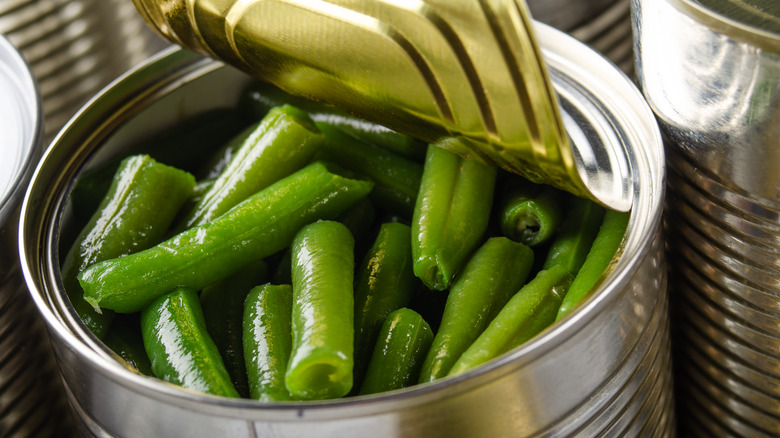
Canned green beans are cheap and convenient, but they can taste plain and oddly tangy, which isn't to everyone's taste. Green beans also tend to be kind of soft. Yet they're so easy to find and so nutritious that it doesn't make sense to avoid them, assuming you're not allergic to them. You just need ways to give those green beans some oomph and make them taste much better than they do straight out of the can.
The good news is that canned green beans soak up flavors easily and pair well with all kinds of foods, which can improve the final dish's texture. Whether you want a light side dish for summer or a savory snack, you can find something that will turn your green beans into a dish to remember . Here's a list of ingredients you can use to make those canned green beans taste less like something that you dragged out of a back corner in your pantry and more like something you'll want to eat again and again.
This first one shouldn't be much of a surprise. After all, ham and green beans are a well-known pairing, so using bacon to spruce up this vegetable is a natural extension of that. You've got a couple of options. You could add some fried and crumbled bacon as a topping for the green beans right before serving them, or you could fry the bacon and then add the beans and some water to the same pot, and let the beans cook in the bacon-water concoction on low heat for a couple of hours. You'll get more bacon flavor in the beans with the second method, but it will obviously take longer. With just a few more ingredients, you can make bacon and green beans the star of your meal with this copycat Texas Roadhouse green beans recipe .
Bacon has another characteristic that could keep you coming back for more: It may actually be a rather addicting food. That isn't a joke — the saltiness and fattiness of bacon make it an almost perfect candidate for food addiction. A 2015 study from the PLoS One journal found that processed foods were associated rather closely with addiction-like eating habits. This means you should watch how much bacon you add and how often you make dishes with bacon and green beans because you could easily have more of it than you intended to eat.
How does that saying go? "Butter makes everything better?" It's very true for vegetables, including canned green beans. Pouring melted butter over the green beans or sauteing the vegetables in melted butter gives the beans a lovely, buttery taste while coating them in a sheen of fat that makes them look so appetizing and rich. If you or anyone in your family just can't stand the taste of canned green beans, sauteing the vegetables in salted butter should cover up much of the beany taste.
Be aware that canned beans already contain salt, so adding salted butter will increase the sodium content even more. If you are monitoring your salt intake, consider using low-salt or no-salt canned green beans or even unsalted butter.
You should also note the one issue with butter, which is that it can burn easily. Lightly browning the butter is one thing — that can taste very nice. But butter has a low smoke point and can actually burn, which makes it taste bitter. Keep the heat low when using butter for your green beans, and keep an eye on the color. Stir the butter and beans constantly. If the butter is a light to light-medium brown, you've only browned the butter and given it a nutty taste. But if it turns a dark brown, it's burnt and won't taste good. At that point, you'll want to start over with another can of beans and fresh butter.
Herbs and seasonings
While using herbs and seasonings with canned green beans may not be the most earth-shattering choice, it's still worth mentioning. People often forget that small changes like adding a little garlic powder can make all the difference. One important thing to note about using spices is that they not only have their own distinct taste, but they also fall into categories like delicate, strong, sweet, and savory. If you want to give canned beans a medium (not strong but not delicate) flavor but don't want garlic, try basil, dill, or thyme instead. If you want a peppery taste but don't want to use pepper, mustard would be an option. Want to see if a sweet combination would work? Try cardamom or fennel. Be aware that cardamom is also considered a strong flavor while fennel is a medium flavor.
Try both dried and fresh herbs to see how they differ. Add fresh herbs after seasoning the beans with salt and pepper, or try using dried spices and herbs in place of salt. If you're serving the green beans to kids or to adults who just do not like vegetables, the herbs and spices could help them eat more of the dish. A 2018 study in the Food Quality and Preference journal found that herbs and spices increased positive views of vegetables among rural high school students; the teens ate more vegetables when they were seasoned with herbs and spices as compared to seasoning with just salt and oil.
Ranch seasoning powder
Powdered ranch seasoning may not seem like the most obvious addition unless you're a major ranch dressing fan — especially because you could just pour ranch dressing itself on the beans like you would a salad. But sprinkling a little powder onto the beans allows you to add more of that distinct ranch flavor without making them gooey. The powder also provides fewer calories than you'd get with the dressing. Other options include mixing the ranch powder into Greek yogurt or cottage cheese to form a low-calorie dip for individual green beans.
You can get shaker containers of the ranch dressing powder if you plan to use it a lot, or you can keep a few packets of the dressing mix around and sprinkle a little powder on green beans now and then. Remember that the moisture on the beans will likely make the powder dissolve a bit. You can try cooking the beans a little to see if the moisture will evaporate.
Lemon juice
Canned green beans do have that weird, almost-sharp taste straight out of the can, and that may make eating a lot of the beans rather unpleasant. Yes, some of you might love that taste, and that's good! But for those of you who aren't thrilled with the flavor, there is an option that doesn't involve extra cooking or adding anything else that would increase the bulk or size of the final dish. The texture of the beans wouldn't change, nor would the color. That magic ingredient? Lemon juice.
A squeeze of lemon juice or a bit of zest sets off a literal chain reaction in your mouth that helps enhance the taste of canned green beans. The acidity of the juice makes your mouth water, and the resulting increase in saliva actually makes it easier for your taste buds to detect the lemony flavor. The sourness of the lemon, too, should help cover the almost-sharp flavor of the canned beans. For the best results, add the lemon juice just as you're about to serve the beans.
Fried onions
If you're tired of the soft, monotonous texture of canned green beans and want some real crunch in every bite, turn to a holiday staple: the french fried onion. The crispy, somewhat greasy fried onion bits that top a traditional green bean casserole at Thanksgiving are terrific in canned green beans even without all the other ingredients. You can do something as simple as mixing the fried onions with canned green beans, with no other cooking or additions. Have a little extra time on your hands? Try our recipe for green bean casserole pastry bites that comes together just four ingredients.
About the only limit you need to place on how much fried onion you use has to do with the fact that the onion is fatty and salty. That's a great taste combination to mix with vegetables, but you should keep your health and the concept of moderation in mind. Mix in enough fried onion bits to turn the beans into something really delicious, but don't add so many that the dish stops being "green beans with fried onions" and becomes "fried onions with some green beans." Also, you don't want your intake of fat and sodium to go off the charts, which is all too easy to do with fried onions.
Sliced or slivered almonds
A classic combination you can turn to is almonds and green beans. Use slivered or sliced almonds instead of whole ones, add some lemon zest and seasonings, and you have a classic green bean almondine , which makes a perfect pairing with a porterhouse steak . Depending on the recipe, you could eat the almondine as-is or roast it a bit in the oven. It's a simple dish that uses ingredients commonly found in even the most basic of kitchens — not to mention, you can make it quickly.
Almonds have a distinct but mellow taste that doesn't overwhelm the green beans but does counter the tangy flavor. In fact, almonds can go with pretty much anything. Check online, and you'll find anecdotes about finding almonds on pizza and speculation about using crushed almonds in place of sesame seeds in sushi. People wax poetic about all the syrups and liqueurs made from almonds that are used in cocktails, like orgeat, for example. And don't forget all the green salads you can find that use almonds as a topping. If you've got a can of green beans that tastes particularly flat, add some toasted almonds and enjoy.
Sliced mushrooms
Canned green beans are nutritious, but they're not providing a huge chunk of your daily nutrition unless you eat a lot of them, which not everyone wants to do. Plus, as healthy as they are, they don't contain every nutrient. You'll need to combine the beans with other foods to create a dish that has a better mix of vitamins, minerals, and macronutrients, and mushrooms are one such food you can use. Depending on the variety of mushroom, you could add more copper, B vitamins, and vitamin D to those green beans. Shiitake mushrooms contain varying levels of vitamin B12, for example, while green beans have none.
Another benefit to using mushrooms is they're one of those foods that falls into the umami taste category. They can change the plain flavor of the beans into one that seems fuller and more savory and thus more satisfying. For even more of a savory, umami punch, try adding soy sauce to the mushrooms and green beans, or bake the mushrooms and green beans with sun-dried tomatoes and shredded Parmesan cheese. Try using miso paste, or adding the canned green beans and mushrooms to a miso-based broth. You can also create a dipping sauce with fish sauce that incorporates mushrooms and green beans.
Softened dried cranberries
A lot of times, when you're trying to combine flavors, you want to tame the overbearing parts and gain a better balance between sweet and sour. With canned green beans, that usually means toning down the tangy taste of the vegetable. But sometimes, adding other tangy flavors works just as well. Dried cranberries — not necessarily sweetened, although you could use those, too — help cover up what can admittedly be a metallic taste that the beans sometimes acquire when canned. However, don't just toss dried cranberries from the bag directly into the canned green beans. Simmer the cranberries in a little water or sauté them in olive oil first to get them soft and warm.
The cranberries also add texture, even when softened. Canned green beans are relatively easy to bite through, at best, and mushy at worst. Dried cranberries are a little chewy, which makes the combination seem more substantial. Dried cranberries are a very common addition to salads in general.
Orange segments
If you're already adding cranberries or lemon juice to your fresh or canned green beans, you will likely also enjoy them paired with orange segments. The sweetness of the oranges complements both the beans and the cranberries, and the citrus fruit adds a freshness that dried fruit and canned beans don't have. Use firm orange segments with none of the white pith or membranes. Pith has a bitter taste that will interfere with the sweetness you're aiming for — and make sure to taste an orange segment before adding it to the beans to ensure the fruit is truly sweet.
Why would canned green beans taste good when laced with orange segments, of all things? Remember that orange and cranberry work very well together in many recipes, and orange and almond flavors also work well (almond flavor tends to pair well with fruit as a whole). So, if cranberries and green beans taste good, and almonds and green beans taste good, it's not that much of a leap to see how oranges and green beans would also work together.
Chicken bouillon
If you're not keen on adding other foods or pungent dressing mixes to your green beans, try using chicken bouillon cubes or powder to add more savory flavor . Put the green beans in a pot with enough water to barely cover them, add the bouillon, and then include whatever seasonings you want. As the water simmers, the bouillon will dissolve, and the resulting broth will add flavor to the beans.
The one thing to look out for with this combination is sodium, or rather an excess of it. Regular canned beans and bouillon are both known for relatively high amounts of sodium. If you use the water in the can of green beans for the broth, you risk having way too much sodium swirling around those beans. Draining the canned green beans and using fresh water helps a lot, but it's also good to look for low- to no-sodium bouillon as well as reduced-sodium canned green beans if possible.
Other canned beans
There's a reason that recipes like three-bean salad contain canned green beans: They pair well with other beans and the vinegary dressing, and they're already soft enough that you don't need to cook them any further. This is an advantage if it's summer, the weather's hot, and you're using all canned beans to avoid turning on the stove. It's great for meal prepping; just remember to keep your perfect summertime salads refrigerated.
Three-bean salad is one of those recipes where everyone has their own go-to version, and sometimes the "beans" in the title refer to three types of legumes, or it might mean two types of legumes plus the green beans. The basic combination for most recipes is green beans (canned in this case, but you can also use thawed-from-frozen beans), red kidney beans, chickpeas, and/or white beans covered with an oil-and-vinegar dressing and maybe some herbs. If you don't already have a recipe of your own, start making a few recipes from other sources and experiment with changing the amount of dressing or adding other herbs to customize the salad to your taste.
- Click here - to use the wp menu builder
Gardening Business
- Backyard Gardening
- Balcony Gardening
- Container Gardening
- Indoor Gardening
- Kitchen Gardening
- Roof Gardening
- Terrace Gardening
- Aeroponic Gardening
- Aquaponic Gardening
- Hydroponic Gardening
- Vertical Gardening
Organic Gardening
- Community Gardening
- Greenhouse Gardening
- Polyhouse Gardening
- Shade Net Gardening
Urban Gardening
Home Gardening
Outdoor Gardening
Modern Gardening
Beans Seed Germination, Time, Temperature, Process
Table of contents, requirements for beans seed germination process, the time frame for beans seed germination, moisture requirement for beans seed germination, pre-sprouting benefits, soaking beans seed for better germination, conditions for bean seed germination, stages of bean seed germination, fast germination of beans seeds in warm soil, gardening tips for growing beans from seed, paper towel germination method for beans seed, common pests and diseases in beans plants, beans harvesting.
Introduction to Beans seed germination process: A bean seed begins to germinate when the soil reaches the right temperature requirement and moisture penetrates the seed coat. Under the right conditions, a seed will sprout rapidly, but if the soil is too cold it will just rot. Bean plants are frost-sensitive annuals that grow best during the warm season and plants are among the easiest vegetables to grow.
A step by step guide to beans seed germination process
Bean plant is certain leguminous plants of the family. Rich in protein and providing moderate amounts of iron, thiamin, and riboflavin, beans are used worldwide for cooking in fresh or dried form. The common bean can be bushy, vine-like or climbing depending on the plant variety being grown. The plant leaves grow alternately on the stems, are green or purple and are divided into 3 oval leaflets with smooth edges. In this article we also discussed below topics;
- Time to take bean seeds take to germinate
- Bean seeds germination period
- Tips for bean seeds germination
- Best times to plant bean
- Germinate bean seeds indoors
- Bean seed germination time
- Bean seed germination temperature
- Paper towel germination method for growing beans
- How do you make beans grow faster
- Best way to plant beans
Growing beans in your home garden and serving these low-fat, high-fiber, protein-rich legumes can be a money-saving and rewarding experience. Beans are a healthy good that is loaded with protein and carbohydrates. Beans contain plentiful Iron and Calcium, which are extremely important nutrients for the body.
Plant seeds directly into the garden bed so you won’t have to transplant later. Once the seed germinates, a bean seed resents root disturbance. Plant the bean seeds about 1 inch deep and 3 inches apart in the garden bed. Choose a spot in full sun with loose, well-draining soil. Beans are seeds that have cells that grow into plants. All the nutrients necessary for this process are present in the seed. Plant the beans in rows and the spacing between rows should be about 24 to 36 inches. The gap between the bean seeds or plants should be around 3 to 4 inches. Plant at a depth of about 1 to 2 inches.

Under good conditions, beans germinate in 8 to 10 days. Beans may take 2 weeks or longer if the soil temperature is under 60°F. Wait until daytime temperatures are above 75°F before planting bean for fast seed germination.
You should not miss the Potato Seed Germination Process .
Many people soak bean seeds before planting, but this procedure can hamper germination by causing the seeds to crack or rot. Beans seed germinate best in evenly moist, but not soggy soil. Heavy clay soils tend to stay wet longer in the spring and amend them with organic matter such as compost or manure to improve drainage or plant green beans in raised beds.
Pre-sprouting the seeds allows you to decide which ones are viable and eliminates the task of thinning seedlings. Therefore, it saves space in the garden, and by exposing the seeds to ideal conditions, you can give the plants an early start instead of waiting for the soil to warm up to 60°F.
Soaking bean seeds in water could help promote germination. First, fill a bowl with water that’s about 80°F. Put the seeds in the bowl and then place the bowl on a heat mat so the water stays warm. Leave the seeds in the bowl overnight and they can absorb the water and swell. Then, drain the seeds and lay them on a paper towel for a short period until they are dry and easier to handle.
The seed germination speed and overall germination rate in bush bean seeds depend greatly on the conditions. Seeds do not sprout well indoors and transplant poorly. So they should be started in a sunny plant bed outdoors after all danger of frost has passed and the soil has warmed. As with all bean seeds, bush bean seeds need warm conditions to germinate successfully. A soil temperature of 70 to 80°F is ideal, although the seeds sprout at lower soil temperatures with diminished success. Moisture is also key, and it should be monitored strictly to prevent overwatering. The soil should be kept moderately moist while the seeds germinate, but the top 1/2 inch of soil should be allowed to dry out slightly between watering sessions to keep the seeds from drowning.
Germination is the procedure in which a seed, spore, or fungi sprouts, or begins growth. Seed germination process can occur after a period of dormancy and is affected by available light, water, air, and many other variables. They germinate quickly under the right conditions and produce flowers and fruit within 50 to 65 days, depending on the plant variety. If planted too early, though, beans can be slow to germinate or fail to germinate at all. Pay attention to planting times and seed depth. Beans are easy to grow plants and this is why it is a good choice to try for a first-time vegetable gardener. Beans require full sun for at least 6 hours per day. Beans grow best in warm climates and don’t survive well in too cold temperatures.
Bean seeds germinate in around an average of 7 to 10 days. You must keep the soil moist during the germination process. You must water because growing beans need water and will die if the soil gets too dry. And add mulch to the soil to retain moisture. Water your bean seeds regularly. Immediately after planting, give seeds plenty of water to aid in their germination. After planting, you must continue to water the seeds once every 2-3 days, so that the soil is always moist. Avoid overwatering though, as too much water (leaving puddles or pools on the topsoil) will cause the seeds to rot.
You may also like the Growing Methi in Pots from Seeds .
When you start to plant the bean seeds, you have to make a plan. The bean spacing requirement will depend on the variety of the bean that you have chosen. Make sure you have enough space between the plants for simple access when they have grown up. Beans have the added value of being highly nutritious, giving you all the more reason to add them to the garden. Beans produce best in soil with good drainage and lots of nutrients. To prepare the soil, mix in garden compost and gardening topsoil into your garden plot.
There are four stages in the bean plant ;
- The bean seed is the capsule in which the new plant is housed.
- Germination is the procedure in which the baby plant emerges from the seed hull.
- In the next stage, the leaf growth begins when the seedling grows its true sets of adult leaves.
- Flowering stages reveal that the plant has fully matured and ready to begin reproducing.
Beans produce a different variety of seeds, each concealed inside a pod. As the pod matures on the bean plants, it dries and splits open in the sun. The bean seeds will eventually fall out of the hard, dry, pod to the earth, or gardeners can remove them for storage or planting later. Bean seeds are comprised of 2 halves called cotyledons. Each cotyledon has a food source for the emerging plant. New bean plants can live off of the stored food in the cotyledon for many days, if necessary until they can reach nutrients in the soil.
Bean seeds are dicots, which means that each of the seeds is split into 2 sections and attached by a small thin area. During germination time, the bean seed has four distinct stages of development. If the bean seed is planted in soil, not all of the stages are visible since some occur underground. However, seeds are started in water, or a wet paper towel, all four stages of seed germination are easy to observe.
Watch for a small sprout that emerges from the bottom of the seed. This is the main root of the bean and called the radicle. This stage is visible if the seed is germinated above ground. Wait until the second stage of growth when the major sprout emerges from the top of the plant. This sprout is known as the hypocotyl and is the first sign of growth for plants planted in the soil. And the hypocotyl emerges as a looped green stem that bends toward the ground. It could appear as if the bean seed is located at the top of the sprout but these are called the cotyledons.
Watch as the seed goes through the third stage of growth where the stem straightens up. The two cotyledons break apart and turn toward the sun to reveal the first two leaves. Check the sprouted seed to watch for the fourth stage of germination, which occurs when the two cotyledons fall off and additional leaves appear on the bean plant.
Beans take just 7 to 14 days to seed germinate in the soil at 60 to 85°F soil. At 60°F, the minimum temperature for reliable germination, a seed will likely take a full 14 days to emerge. But when the soil reaches the optimum temperature from 70 to 80°F, it will germinate within 7 to 10 days. For the absolute shortest germination time, grow beans in 80°F soil.
Not every seed will germinate accurately. When growing bean plants , you can expect about 70 percent to sprout. In cold soil below 60°F, germination rates go down as some or all of the seeds will rot before they sprout. On the opposite end of the thermometer, the soil gets above 95°F; a bean seed is likely to suffer damage before it can germinate. Once sprouted, seedlings are sensitive to air temperatures below freezing.
You may also check the Growing Swiss Chard Hydroponically .
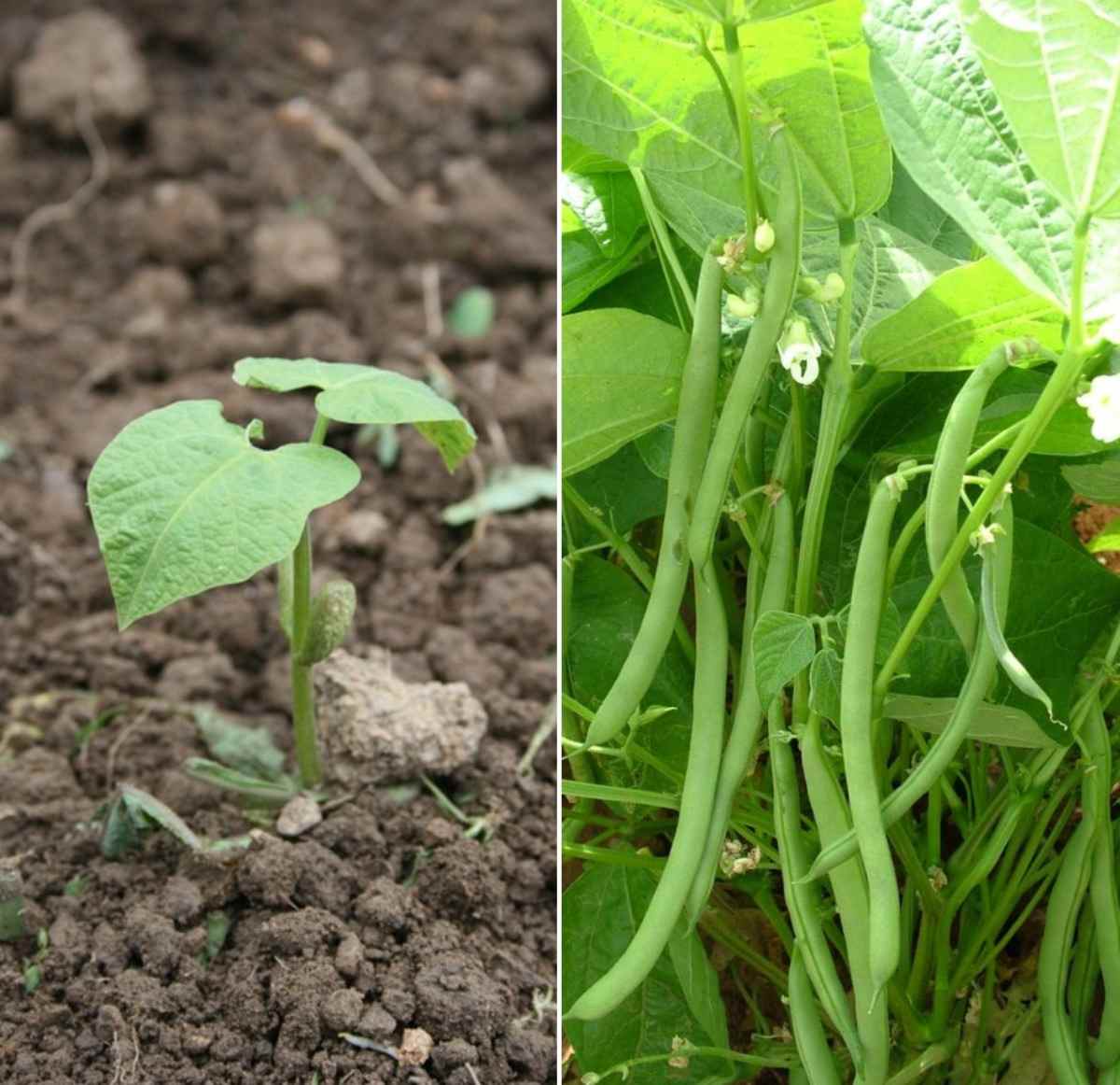
- Bean plants grow better in warm temperatures rather than cooler temperatures.
- Bean plants must be watered at least once a week.
- Beans grow well in well-nourished soil, with homemade compost or manure being ideal providers of good nutrients.
- Insects may grow on the bean plants and could need to be picked off.
- Humid environments cause several problems from the growth of beans. Plant beans 2 to 3 inches apart in the soil.
- Moist soil is the best kind of soil for growing beans. Water is good for bean plants, but too much water can drown them.
- Inserting poles into the soil for the bean plants to grow on will help support them and make them stronger.
Sprouting the seeds indoors for immediate transplanting in early summer could help ensure more even germination and less wasted seed. Beans don’t tolerate transplanting well, so you should sprout them without soil and plant them in the garden before they begin to form roots. You can sprout the seeds without soil on a paper towel to check the viability of old bean seeds or saved seeds before you plant. The bean seed paper towel germination process can be given below;
- First, fold a paper towel in half. And wet the towel with warm water until it’s moist but not soaking wet.
- Sprinkle 10 bean seeds on half of the folded towel and fold the towel over to cover the top of the seeds. Press the top of the towel so the seeds are in full contact with the damp paper towel on both sides of each seed.
- Then place the folded towel inside a plastic zip-top bag. And seal the bag closed and set it in a warm area, such as on top of a refrigerator.
- Wait one week if you are sprouting the bean seeds to check for viability. Count the number of sprouted seeds to find the viability rate. For example, if 7 seeds sprout, you have a viability rate of 70 percent, so you will want to sow an additional three seeds for every 10 planted in the garden to ensure you have enough plants.
- Check the seeds daily if you are pre sprouting the seeds for quicker growth in the garden. Transplant the bean seeds outside, with the sprouted side up and 1 inch deep, as soon as the sprout begins to emerge and before the bean begins to grow a root. Seal the bag closed with the remaining seeds inside and continue to check daily for 1 week or until all the seeds have sprouted.
Common beans can be affected by several diseases. Some of these diseases can remain in the soil for several years, so grow beans in different areas of the garden each year. To prevent the spread of fungal and bacterial diseases among bean plants, avoid working in your bean patch when the foliage is wet. The best method to get rid of beetles and bugs that might eat the leaves of your plants is to pick them off and toss them into a jar of soapy water.
Beans can be harvested in the snap or green stage, the shelling stage, or the dry stage. Try to harvest beans before the first frost and some gardeners extend their season by covering their plants with sheets, blankets, or row cover ahead of cold weather. Green beans are ready for harvest when the pods are still tender before the bean seeds start to swell. Dry beans are ready for harvest when the pods are dry and brittle and seeds inside are hard.
In case if you miss this: Hydroponic Tomato Farming Guide .
LEAVE A REPLY Cancel reply
Save my name and email in this browser for the next time I comment.
Gardening Techniques in Planting Vegetables
Where to place indoor plants in your home, how to grow tomatoes organically at home: a comprehensive guide, organic gardening on a budget: low-cost methods and materials, gongura seed germination and planting methods, cabbage seed germination and selection, broccoli seed germination and selection, asparagus seed germination and variety selection, seasonal flower gardening: best practices for spring, summer, fall, and..., how to grow hibiscus from flower, plantation ideas for home decoration: a beginners guide, flower garden designs and layouts for beginners, planting and spacing techniques in papaya: a beginner’s guide, growing gold: essential techniques for planting pineapples, how to make kalanchoe plant bushy: home remedies and solutions, 11 reasons why your gardenia is not blooming: home remedies..., eco elegance: the guide to designing a drought-tolerant landscape, gardening on a slope: strategies for hillside landscaping, nourish and flourish: top organic mulches for thriving house plants, everything you want to know about indian mogra flower: discover..., vegetable gardening calendar in india – a full guide, growing betel leaf in pots – a full guide, growing tulsi in pots (holy basil), planting, care guide, growing green chillies in pots (mirchi) – a full guide, bottle gourd terrace gardening (louki) ideas, tips, vastu for planting trees at home – a full guide.
Home / Essay Samples / Education / Research / The Simpler The Funnier: Mr. Bean
The Simpler The Funnier: Mr. Bean
- Category: Life , Education
- Topic: Personality , Research
Pages: 1 (573 words)
Views: 4828
- Downloads: -->
--> ⚠️ Remember: This essay was written and uploaded by an--> click here.
Found a great essay sample but want a unique one?
are ready to help you with your essay
You won’t be charged yet!
Studying Abroad Essays
After Graduation Essays
Brittany Stinson Essays
Indian Education Essays
Academic Interests Essays
Related Essays
We are glad that you like it, but you cannot copy from our website. Just insert your email and this sample will be sent to you.
By clicking “Send”, you agree to our Terms of service and Privacy statement . We will occasionally send you account related emails.
Your essay sample has been sent.
In fact, there is a way to get an original essay! Turn to our writers and order a plagiarism-free paper.
samplius.com uses cookies to offer you the best service possible.By continuing we’ll assume you board with our cookie policy .--> -->